Saint Lucia is a small island in the Caribbean Sea, known for its lush tropical rainforests and stunning beaches. It is home to a variety of birds, both endemic and migratory, that are an integral part of its vibrant and diverse ecosystem.
From the majestic White-breasted Thrasher to the colorful Caribbean Elaenia, Saint Lucia’s birds are a delight to observe. These feathered creatures, along with the rich flora and fauna of the island, contribute to the unique beauty of this Caribbean paradise.
1. Saint Lucia Amazon
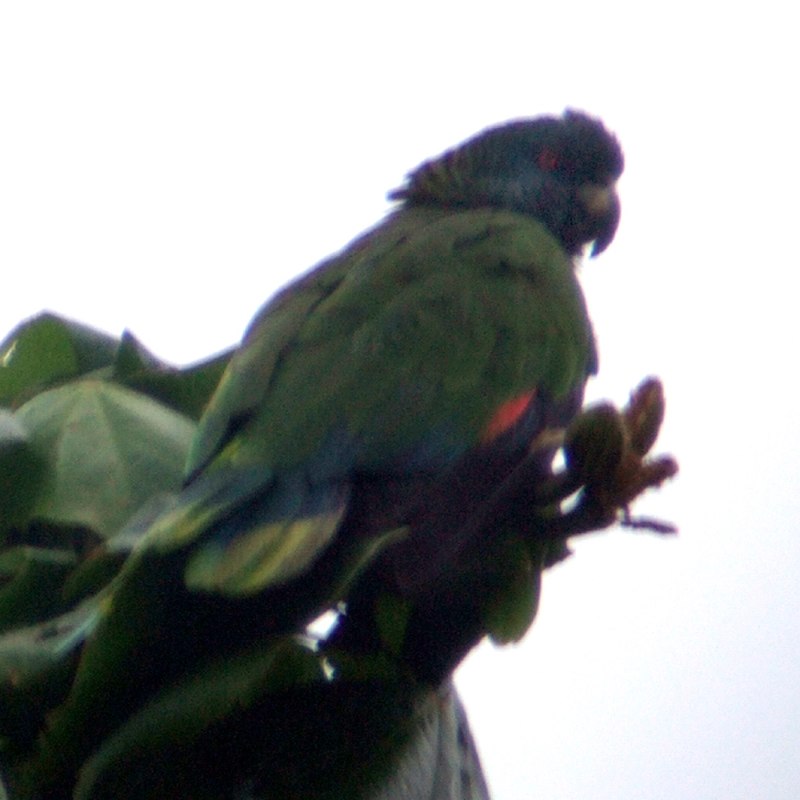
The Saint Lucia Amazon is an endemic parrot species to the Caribbean island of Saint Lucia. It has been designated as the country’s national bird and its population numbers have sadly declined from around 1000 birds in 1950s, to only 150 by late 1970s.
This critically endangered species primarily inhabits moist mountain forests with a subtropical climate which are slowly being destroyed due to deforestation and other human activities.
Conservation efforts such as protection of habitat areas and captive breeding programs have helped increase their numbers but there’s still much work that needs to be done if this iconic symbol of St Lucian pride is going to survive for future generations.Scientific classification:
| Kingdom | Animalia |
| Phylum | Chordata |
| Class | Aves |
| Order | Psittaciformes |
| Family | Psittacidae |
| Genus | Amazona |
| Species | A. versicolor |
2. Saint Lucia Oriole
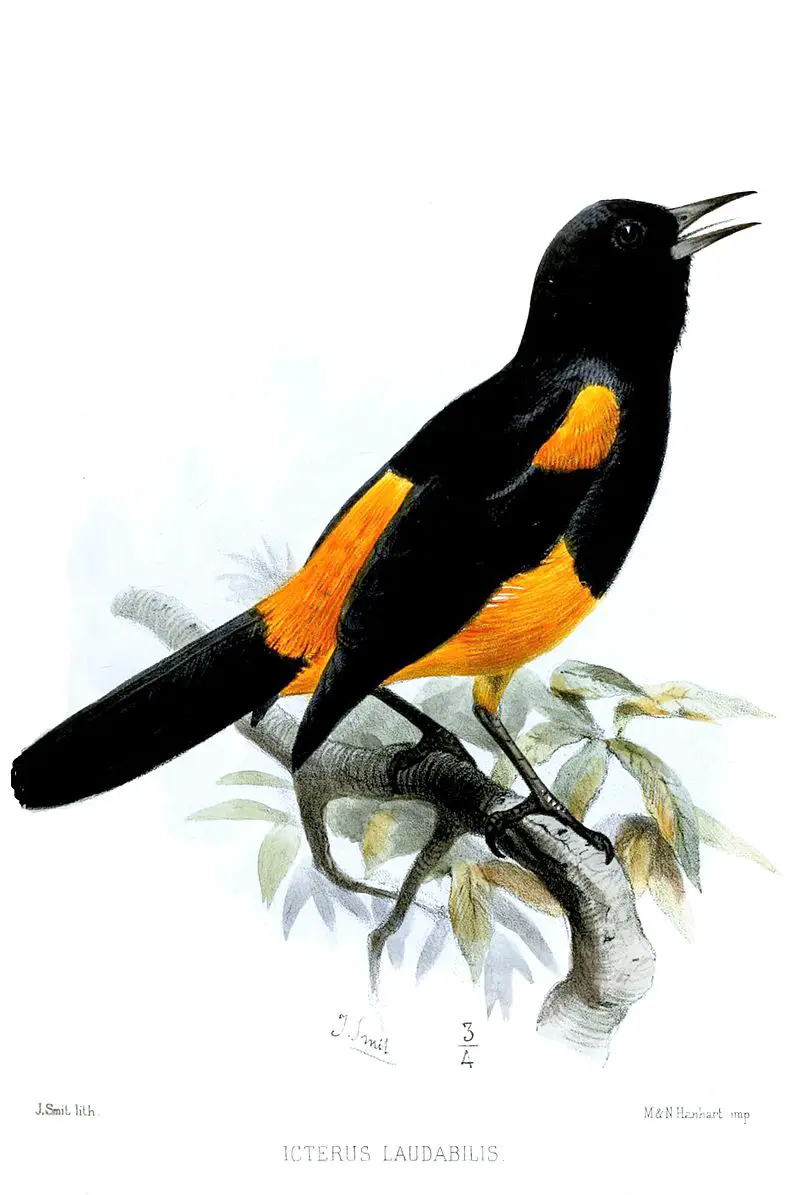
The Saint Lucia oriole is a stunning species of bird found only on the Caribbean island of Saint Lucia.
Its bright yellow and black plumage makes it easily identifiable in its natural habitat, which includes mountain rainforests, coastal scrub forests, primary and secondary forests, plantations (such as banana citrus and coconut) and mangroves near coastlines.
It loves to feed on fruits such as bananas or mangoes when available. They are generally solitary birds but will form small flocks during migration season.
The female builds nests high up in trees with materials like sticks and leaves that she collects from her surroundings while the male stands watch nearby for any predators or intruders encroaching their territory.
Despite being listed as vulnerable by IUCN Red List due to destruction of its native habitats, conservation programs have been put into place so this vibrant little beauty can thrive for many years to come.Scientific classification:
| Kingdom | Animalia |
| Phylum | Chordata |
| Class | Aves |
| Order | Passeriformes |
| Family | Icteridae |
| Genus | Icterus |
| Species | I. laudabilis |
3. Saint Lucia Warbler
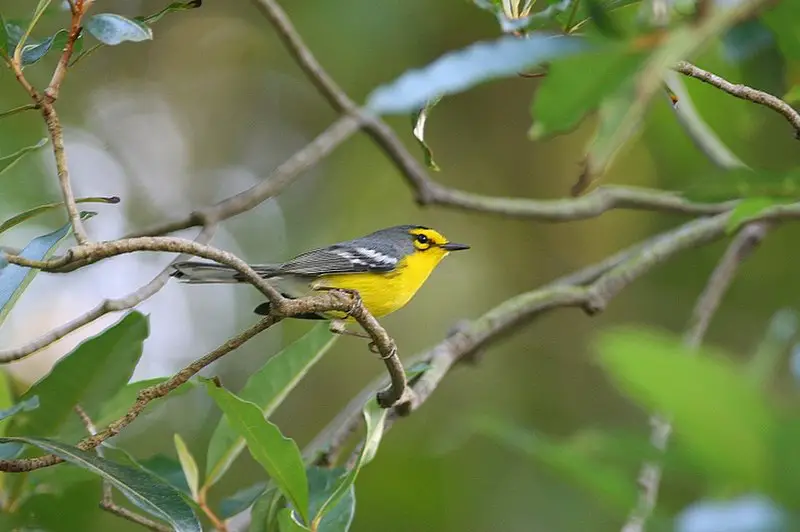
The Saint Lucia warbler is a beautiful bird endemic to the island of Saint Lucia. It belongs to the Parulidae family, and was once considered a subspecies of Adelaide’s Warbler.
The St. Lucian Warbler has yellow-green upperparts with greyish flanks, white underparts and two bold wing bars on its wings which are visible when in flight.
Its tail feathers are usually tipped with yellow or white, depending on the season.
This small songbird prefers humid montane forest habitats for nesting and feeding during breeding season; however it will also venture out into adjacent woodland areas if necessary for food sources such as insects like moths, caterpillars and spiders as well as fruit such as bananas.
Their conservation status is currently listed near threatened due to habitat loss from deforestation but we can help protect them by conserving their natural habitats so that future generations may enjoy these beautiful birds.Scientific classification:
| Kingdom | Animalia |
| Phylum | Chordata |
| Class | Aves |
| Order | Passeriformes |
| Family | Parulidae |
| Genus | Setophaga |
| Species | S. delicata |
4. Tanagers
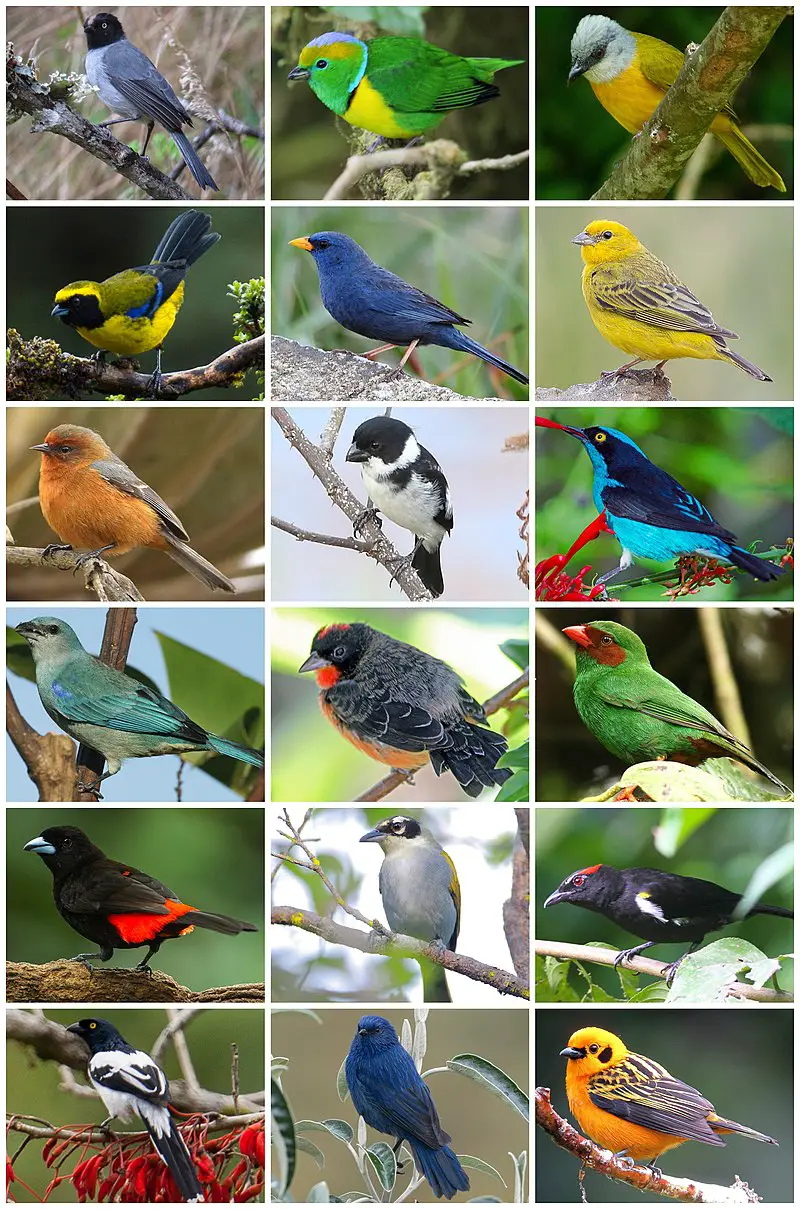
The Tanagers are a beautiful and diverse family of birds native to the Neotropical region. They boast an impressive array of colors, including blues, greens, yellows and reds.
The most common type is the fruit-eating tanager that can be found in tropical forests across Latin America. With nearly 240 species worldwide, they represent almost 4% of all avian species.
These vibrant birds have adapted well to their environment due to their strong bills used for cracking open hard fruits as well as sharp claws for gripping branches while feeding or perching.
As with many other bird families there is natural variation among populations making each one unique in its own way; something that makes them even more special.Scientific classification:
| Kingdom | Animalia |
| Phylum | Chordata |
| Class | Aves |
| Order | Passeriformes |
| Superfamily | Emberizoidea |
| Family | Thraupidae Cabanis, 1847 |
5. Grey Trembler
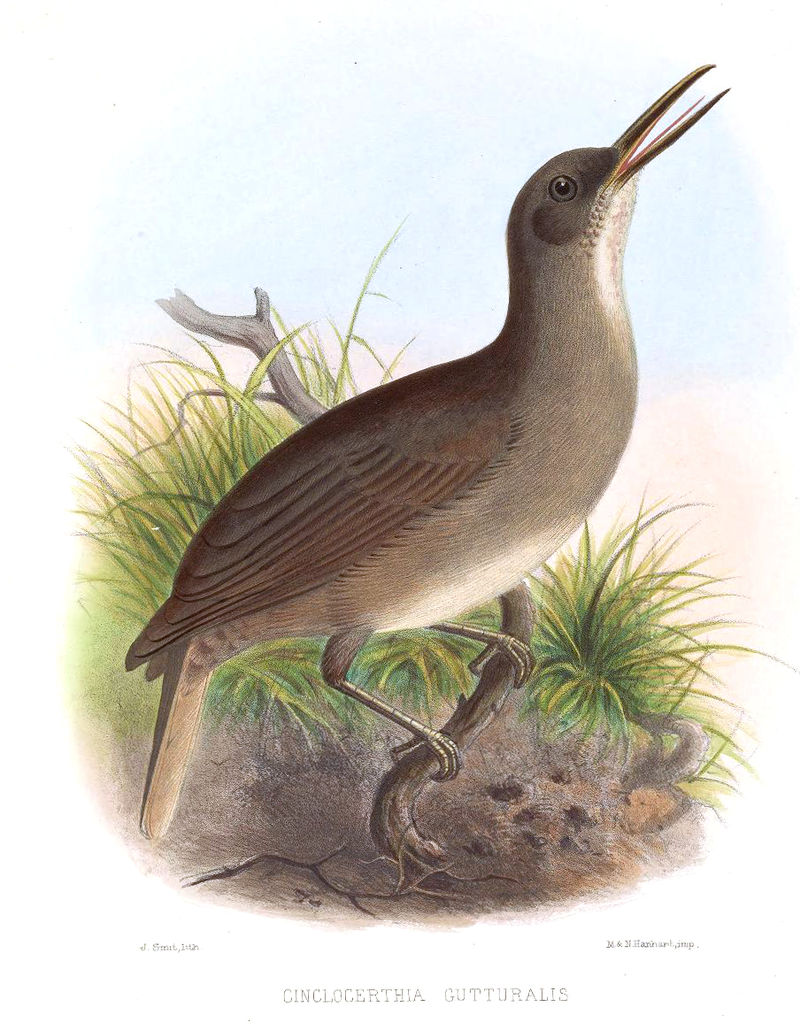
The Grey Trembler is a beautiful songbird found only in the Lesser Antilles of the Caribbean Sea. This species belongs to the Mimidae family, which includes mockingbirds and thrashers.
It has two subspecies – Cinclocerthia gutturalis gutturalis and Cinclocerthia gutturalis sanctaeluciae – both endemic to Martinique and Saint Lucia respectively.
The Grey Trembler was previously thought to be an amalgamation of Brown Tremblers from these islands until it was established as its own distinct species in 2002.
These birds are greyish-brown with white scaly markings on their wings, back and tail feathers; they also have distinctive yellow eyes.
They live mainly in humid forested habitats but can be seen foraging near suburban gardens too. With its melodious singing voice, this bird is sure to bring joy wherever it goes.Scientific classification:
| Kingdom | Animalia |
| Phylum | Chordata |
| Class | Aves |
| Order | Passeriformes |
| Family | Mimidae |
| Genus | Cinclocerthia |
| Species | C. gutturalis |
Also Featured In: Martinique Island Birds You Should Know,
6. Broad-Winged Hawk
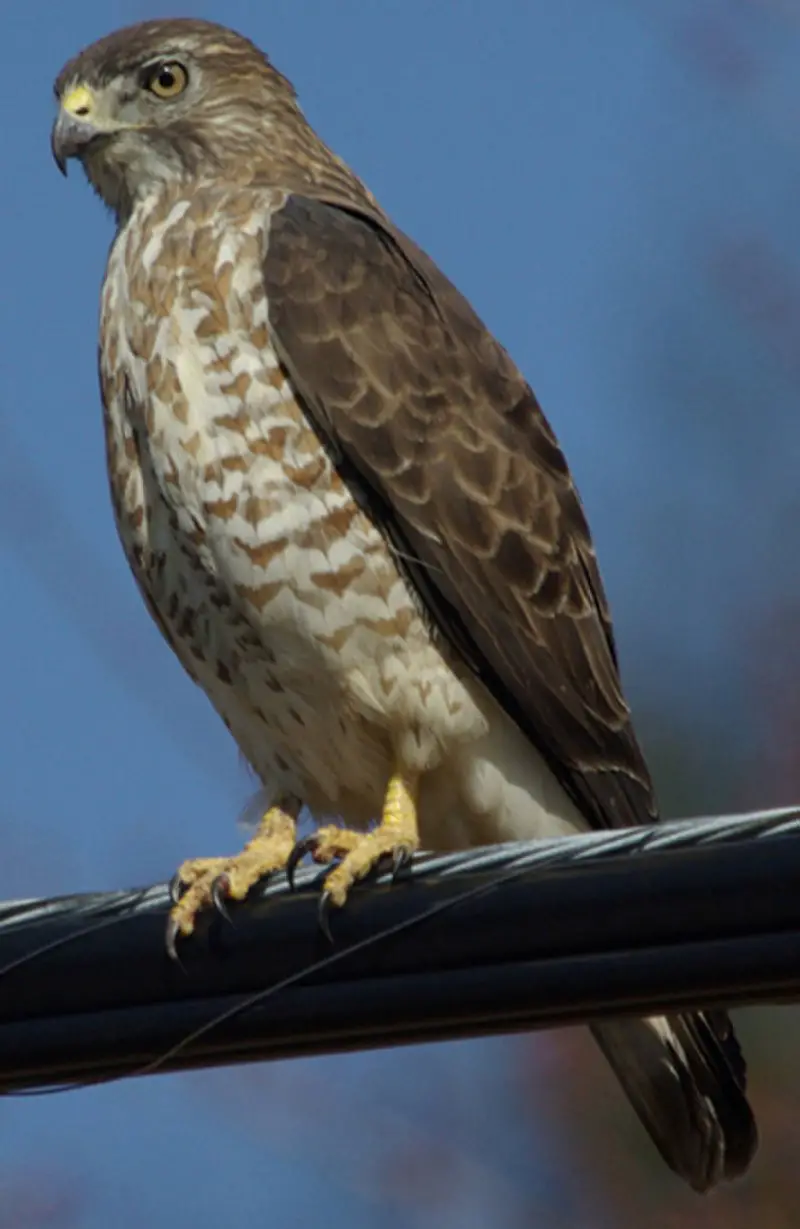
The Broad-winged Hawk is a medium-sized raptor of the Buteo genus. It has distinct subspecies which are distributed throughout eastern North America, ranging from British Columbia to Texas and migrating south during winter months to places like Mexico and Brazil.
Other subspecies are year round residents in Caribbean Islands. Like most birds of prey, female Broad-winged Hawks tend to be larger than males – they can have wingspans up to 48 inches.
These hawks feed mainly on small mammals such as mice or voles but also eat insects, reptiles and amphibians too.
They nest high in trees typically near open fields where food sources abound; their nests are often made with sticks lined with grasses or other materials for insulation purposes.Scientific classification:
| Kingdom | Animalia |
| Phylum | Chordata |
| Class | Aves |
| Order | Accipitriformes |
| Family | Accipitridae |
| Genus | Buteo |
| Species | B. platypterus |
Also Featured In: British Columbian Birds, Birds in Iowa Spring
7. Lesser Antillean Bullfinch
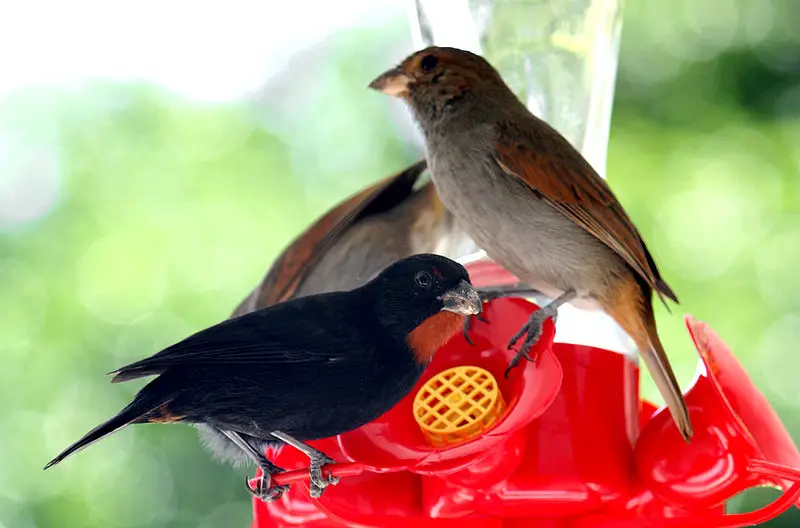
The Lesser Antillean Bullfinch is a species of bird found throughout the Caribbean islands. It has greenish-brown feathers, white cheeks and wings with black spots, and red-orange legs.
Its natural habitats include forests, mangroves and shrublands. This small finch feeds mainly on fruits but also eats insects such as caterpillars and moths in addition to nectar from flowers.
They are often seen foraging near flowering trees during the breeding season when they build nests made out of grasses or plant fibers lined with soft downy feathers for their young ones to rest in comfortably.
These birds have adapted well to human presence so can be easily spotted around gardens within cities where they come looking for food scraps left by people.Scientific classification:
| Kingdom | Animalia |
| Phylum | Chordata |
| Class | Aves |
| Order | Passeriformes |
| Family | Thraupidae |
| Genus | Loxigilla |
| Species | L. noctis |
Also Featured In: British Virgin Islands Birds You Need to See, Winged Marvels of St Martin’s: A Bird Enthusiast’s Delight
8. Frigatebird
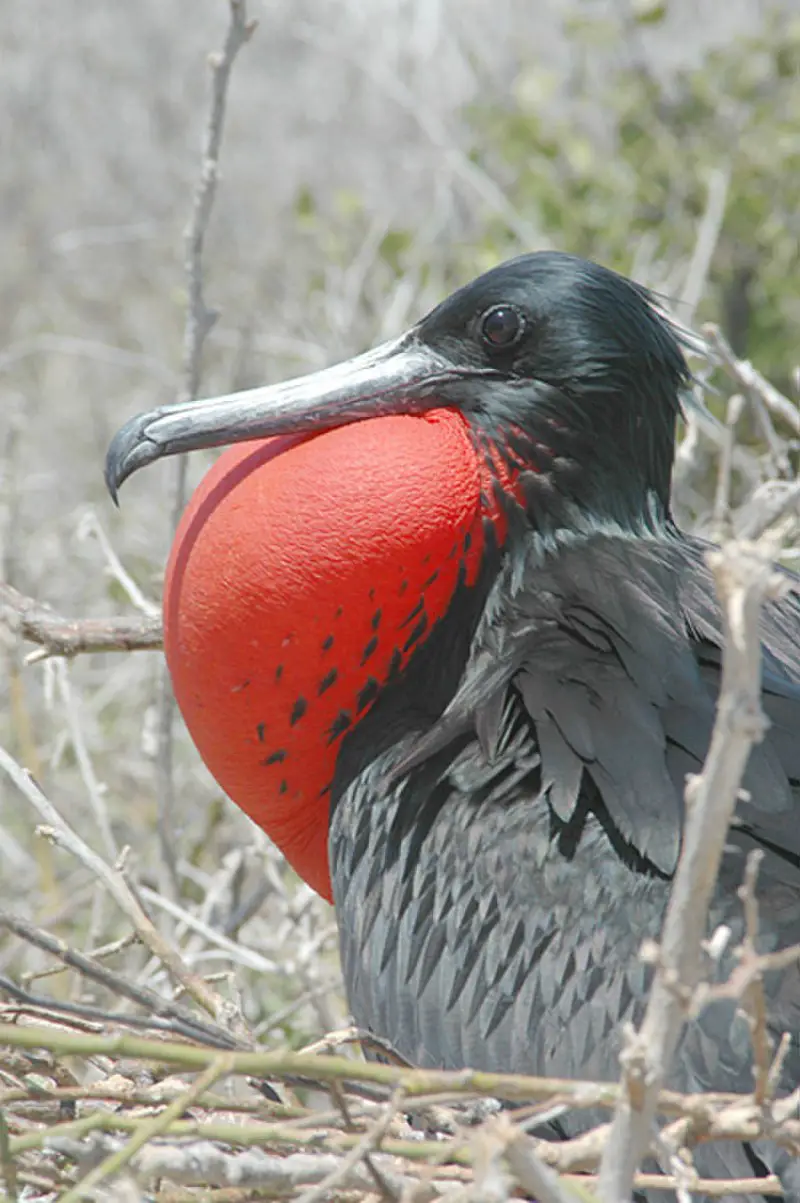
Frigatebirds are a beautiful and mysterious family of seabirds, found in all tropical and subtropical oceans. The five extant species have glossy black plumage, long forked tails, and lengthy hooked bills.
During the breeding season males display a bright red gular pouch which they inflate to attract mates. Females have white underbellies year-round giving them an elegant contrast against their darker feathers.
They spend most of their lives soaring with minimal effort over warm ocean waters seeking food such as fish or squid taken from the surface or plucked out of midair by other birds.
Frigatebirds often nest on isolated islands due to lack of predators yet still manage to travel incredibly large distances between feeding grounds every day making them truly remarkable creatures.Scientific classification:
| Kingdom | Animalia |
| Phylum | Chordata |
| Class | Aves |
| Order | Suliformes |
| Family | Fregatidae Degland & Gerbe, 1867 |
| Genus | Fregata Lacépède, 1799 |
9. House Wren
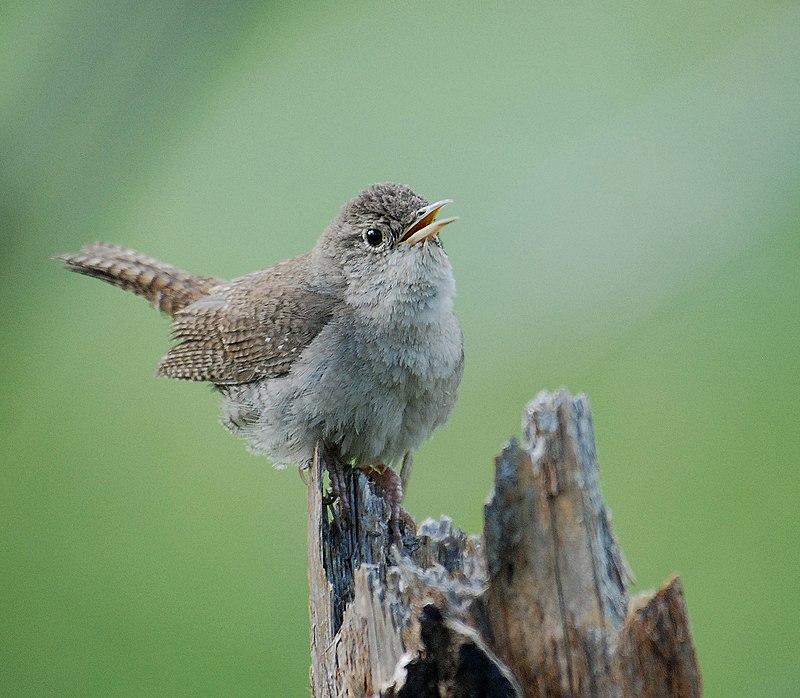
The House Wren is a small bird of the wren family found from Canada to South America. It’s quite common in suburban areas and is one of the most widely distributed native birds in North and South America.
Its taxonomy can be complicated, with some subspecies groups considered separate species.
The House Wren has a brown back, grey head, white eyebrow stripes, light chestnut belly and buffy flanks.
They often inhabit old or abandoned buildings as well as shrublands near fields or open woods for nesting sites.
During breeding season they are highly territorial so make sure you create an inviting environment if you wish to invite them into your yard.Scientific classification:
| Kingdom | Animalia |
| Phylum | Chordata |
| Class | Aves |
| Order | Passeriformes |
| Family | Troglodytidae |
| Genus | Troglodytes |
| Species | T. aedon |
10. Tyrant Flycatchers
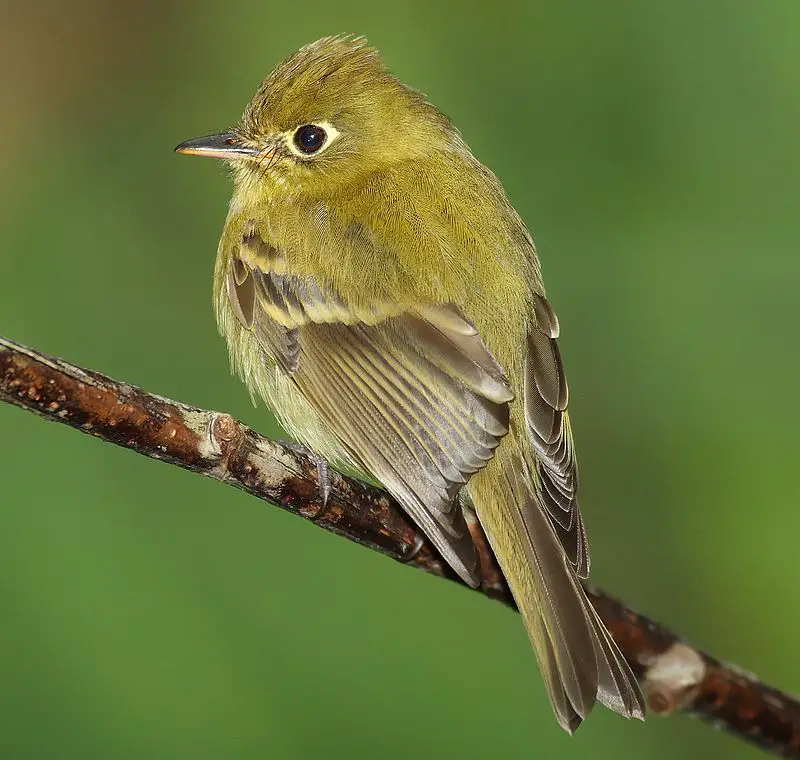
Tyrant flycatchers are a family of birds found in North and South America, containing over 400 species. These birds come in an array of shapes and sizes, with vibrant plumage to match.
They�re the most diverse avian family across all countries they inhabit except for the United States and Canada.
Their diet consists mainly of insects but also includes small reptiles or amphibians where available.
The behavior varies between each bird; some prefer open areas while others like dense forests as their habitat � many even migrate regularly.
Tyrant Flycatchers have adapted well to human presence thanks to the abundance of food sources that often accompany it � such as backyards, parks etc..
All things considered these incredible creatures are truly amazing.Scientific classification:
| Kingdom | Animalia |
| Phylum | Chordata |
| Class | Aves |
| Order | Passeriformes |
| Parvorder | Tyrannida |
| Family | Tyrannidae Vigors, 1825 |
11. Bananaquit
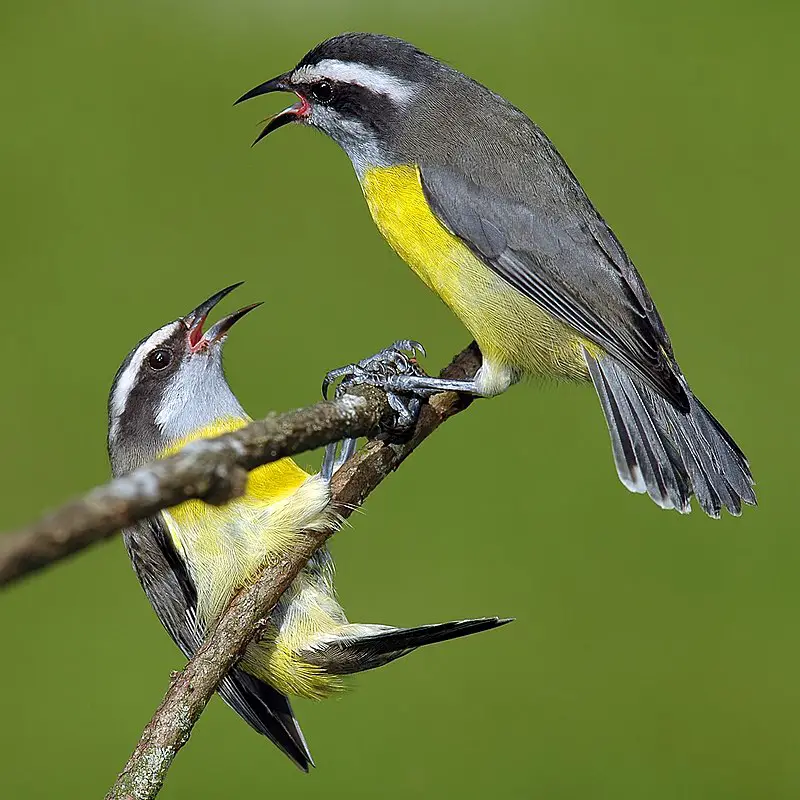
The Bananaquit, scientifically known as Coereba flaveola, is a small passerine bird belonging to the tanager family Thraupidae.
It was previously classified in either its own monotypic family or with other species such as buntings and New World sparrows (Emberizidae) or warblers (Parulidae).
This beautiful little bird has a yellow-green upper body, pale grey head and chestnut brown wings.
Its tail feathers are blackish while its belly is white with some faint streaks of olive green coloration.
The bananaquit can be found across Central America and the Caribbean islands where it feeds on fruits like bananas for which it gets its name from.Scientific classification:
| Kingdom | Animalia |
| Phylum | Chordata |
| Class | Aves |
| Order | Passeriformes |
| Family | Thraupidae |
| Genus | Coereba Vieillot, 1809 |
| Species | C. flaveola |
12. Antillean Euphonia
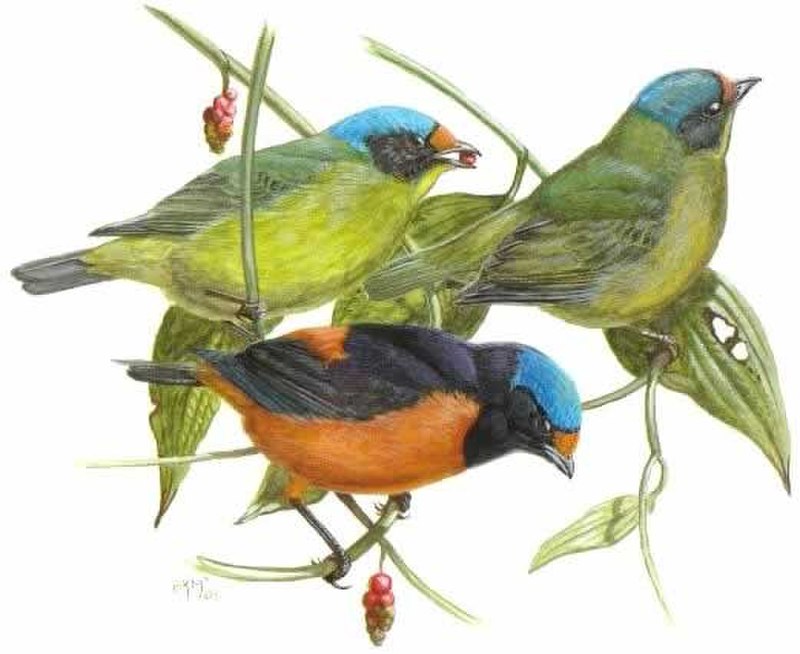
The Antillean euphonia is a colorful and beautiful bird species found across the Lesser Antilles, Hispaniola (Dominican Republic and Haiti) and Puerto Rico.
It belongs to Fringillidae family of finches. This small songbird has strong yellow feathers on its head with blue-green upperparts while they have bright orange breasts and bellies.
Their wings are blackish with white tips, giving them an attractive look when flying in flocks through woodlands or forest edges.
They inhabit subtropical or tropical dry forests as well as moist lowland forests including degraded former ones too.
The populations of this species are declining due to deforestation but still remain common throughout their range if habitats can be preserved for their long term future survival.Scientific classification:
| Kingdom | Animalia |
| Phylum | Chordata |
| Class | Aves |
| Order | Passeriformes |
| Family | Fringillidae |
| Subfamily | Euphoniinae |
| Genus | Chlorophonia |
| Species | C. musica |
13. Forest Thrush
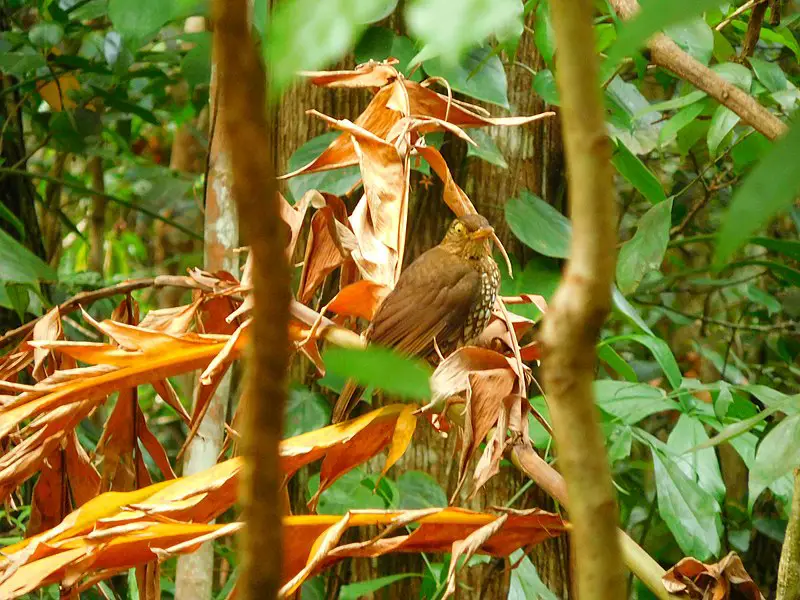
The Forest Thrush is a species of bird in the family Turdidae, found mainly in Central America. It has brown upperparts and pale underparts with scaly patterning on its feathers.
This medium-sized thrush measures 25 to 27 cm long and weighs between 100 to 110 grams.
Its diet consists mainly of fruits, insects, lizards and snails; it also sometimes feeds on small mammals like mice or shrews.
The female lays two eggs which she incubates for around 15 days before they hatch into young chicks who will remain dependent upon their parents until adulthood at around one year old.
These birds are very social creatures living within flocks that can number up to 30 individuals during the breeding season but may reduce down to four members outside of this period.Scientific classification:
| Kingdom | Animalia |
| Phylum | Chordata |
| Class | Aves |
| Order | Passeriformes |
| Family | Turdidae |
| Genus | Turdus |
| Species | T. lherminieri |
Also Featured In: Common Birds Found near Montserrat, Native Birds Of Guadeloupe Island
14. Lesser Antillean Pewee
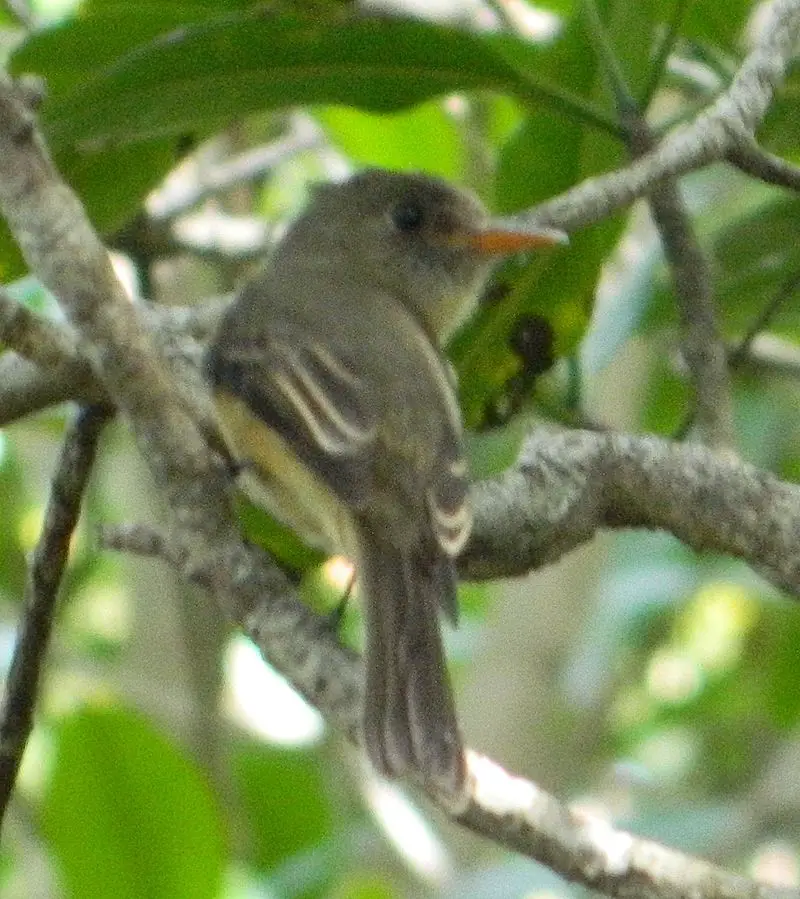
The Lesser Antillean pewee is a species of bird found in the family Tyrannidae. It can be spotted in Dominica, Guadeloupe, Martinique, Puerto Rico and Saint Lucia with records from Saint Kitts.
In fact some experts suggest that birds on Puerto Rico are different enough to be considered their own species (Puerto Rican pewee) while those living on St Lucia are also distinct enough to have been named ‘St Lucian Pewees’.
This small songbird prefers habitats like tropical or subtropical moist lowland forests as well as heavily degraded former forest areas.
With its drab grayish-brown plumage it’s rather unassuming but during breeding season males will give a distinctive “churrr” call which makes them easier to spot.Scientific classification:
| Kingdom | Animalia |
| Phylum | Chordata |
| Class | Aves |
| Order | Passeriformes |
| Family | Tyrannidae |
| Genus | Contopus |
| Species | C. latirostris |
Also Featured In: Birds that You’ll Find in Puerto Rico, Caribbean Birds
15. Purple-Throated Carib
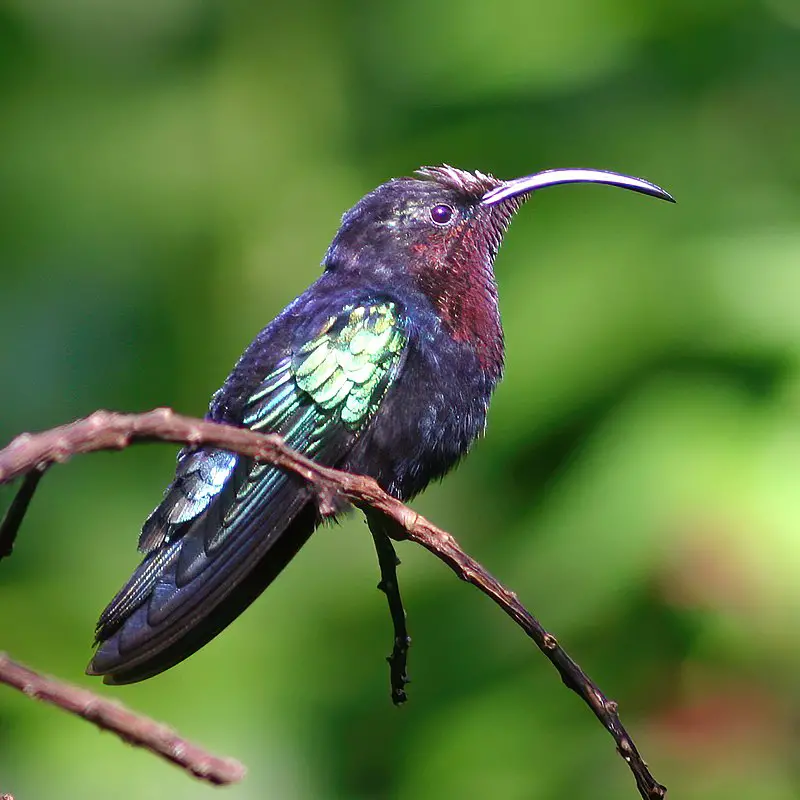
The Purple-throated Carib is a species of hummingbird found in the Lesser Antilles islands. It has stunning purple feathers along its throat, making it quite easy to identify amongst other birds.
This bird is usually seen alone or in pairs and can be found near forests and gardens where they feed on nectar from flowers.
The Purple-throated Carib also feeds on insects which helps keep insect populations under control around their habitat areas.
They are known as strong fliers that have been spotted both north and south of the Caribbean Islands showing just how far this resilient species can travel.
Overall, this vibrant little bird adds beautiful colour to any garden with its mesmerising plumage while providing an essential service at controlling bug numbers too.Scientific classification:
| Kingdom | Animalia |
| Phylum | Chordata |
| Class | Aves |
| Order | Apodiformes |
| Family | Trochilidae |
| Genus | Eulampis |
| Species | E. jugularis |
16. Mimid
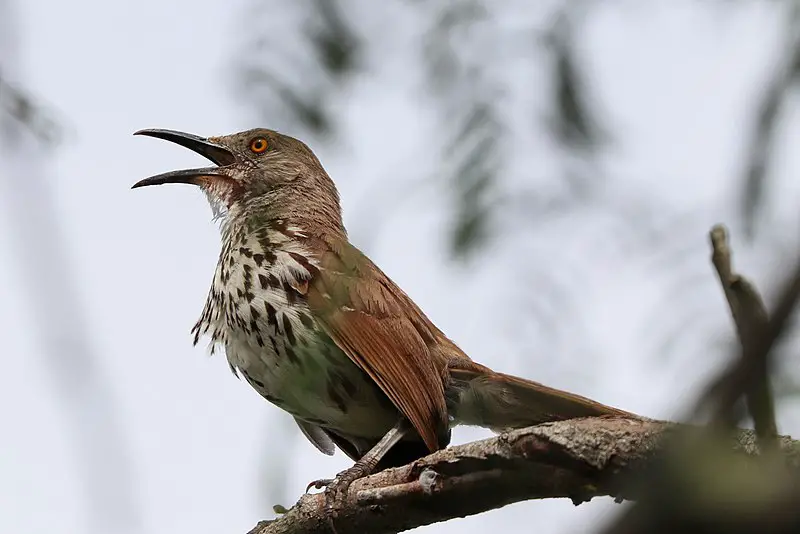
Mimid birds are a diverse family of passerines found in the New World. They have an impressive vocal range and many species excel at mimicking other bird songs, as well as noises from their environment.
Mimids can be identified by their flat heads with short crest feathers, long tails, large eyes and strong legs for hopping between branches.
These birds typically inhabit open woodlands or scrubland areas where they feed on insects such as beetles, caterpillars and grasshoppers.
Some species also supplement their diet with fruits or grains when available. While most do not migrate far during winter months some may undertake longer migrations to warmer climates if necessary to survive cold weather spells.
The wide variety of sounds these talented singers produce make them one of nature’s great musical performers.Scientific classification:
| Kingdom | Animalia |
| Phylum | Chordata |
| Class | Aves |
| Order | Passeriformes |
| Superfamily | Muscicapoidea |
| Family | Mimidae Bonaparte, 1853 |
17. Gray Kingbird
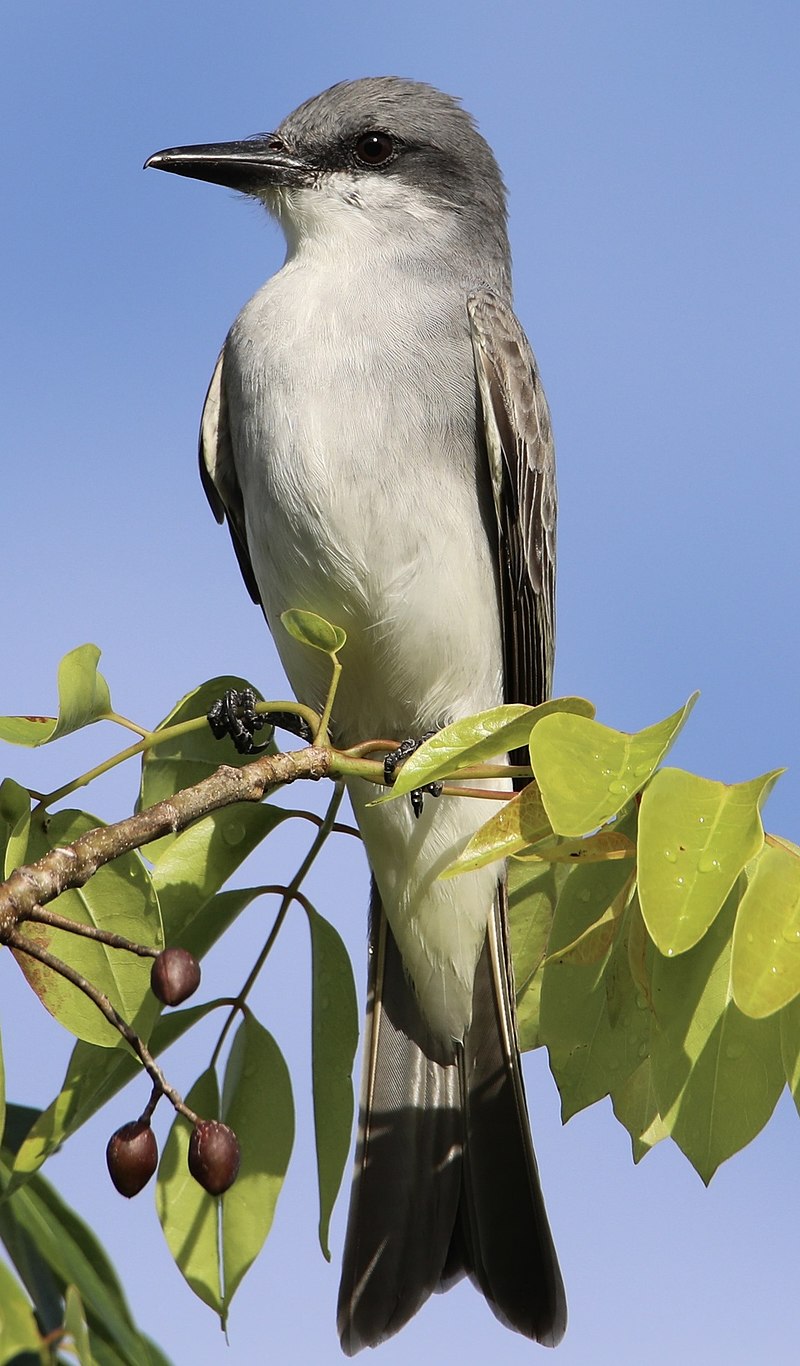
The Gray Kingbird is a species of tyrant flycatcher found in tall trees and shrubs, including the edges of savannas and marshes. It has gray feathers on its back with white underparts and blackish wings.
Its head is dark gray-brown or olive, while its tail is tipped with white. The Gray Kingbird builds flimsy cup nests from twigs in tree branches for their eggs to incubate safely until they hatch into chicks.
They feed mainly on insects such as moths, grasshoppers, beetles, crickets and caterpillars that can be caught midair when it swoops down from above like other kingbirds do.
This bird’s call consists of loud chirps which are often heard during mating season – making them an easily identifiable species within areas where they live.Scientific classification:
| Kingdom | Animalia |
| Phylum | Chordata |
| Class | Aves |
| Order | Passeriformes |
| Family | Tyrannidae |
| Genus | Tyrannus |
| Species | T. dominicensis |
18. Rufous-Throated Solitaire
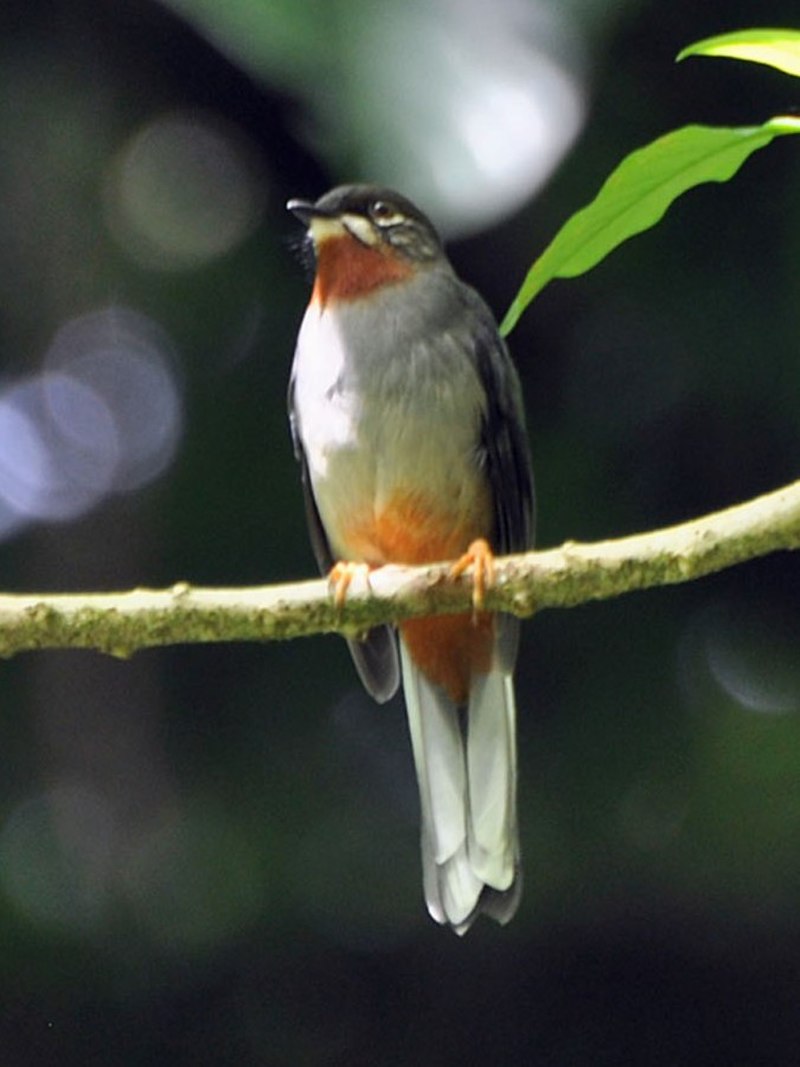
The Rufous-throated Solitaire is a species of bird belonging to the Turdidae family. It can be found in Dominican Republic, Haiti, Jamaica, Martinique and other Caribbean Islands with natural habitats including subtropical or tropical moist lowland forests and montane forests.
This beautiful medium sized songbird has unique characteristics like its greyish brown body colouration combined with an orangey throat that gives it its name; rufous-throated solitaire.
Besides being known by this name they are also nicknamed the ‘siffl’.
Unfortunately due to habitat destruction their population numbers have declined over recent years but conservation efforts are making some progress towards preserving these animals for future generations.Scientific classification:
| Kingdom | Animalia |
| Phylum | Chordata |
| Class | Aves |
| Order | Passeriformes |
| Family | Turdidae |
| Genus | Myadestes |
| Species | M. genibarbis |
19. Lesser Antillean Saltator
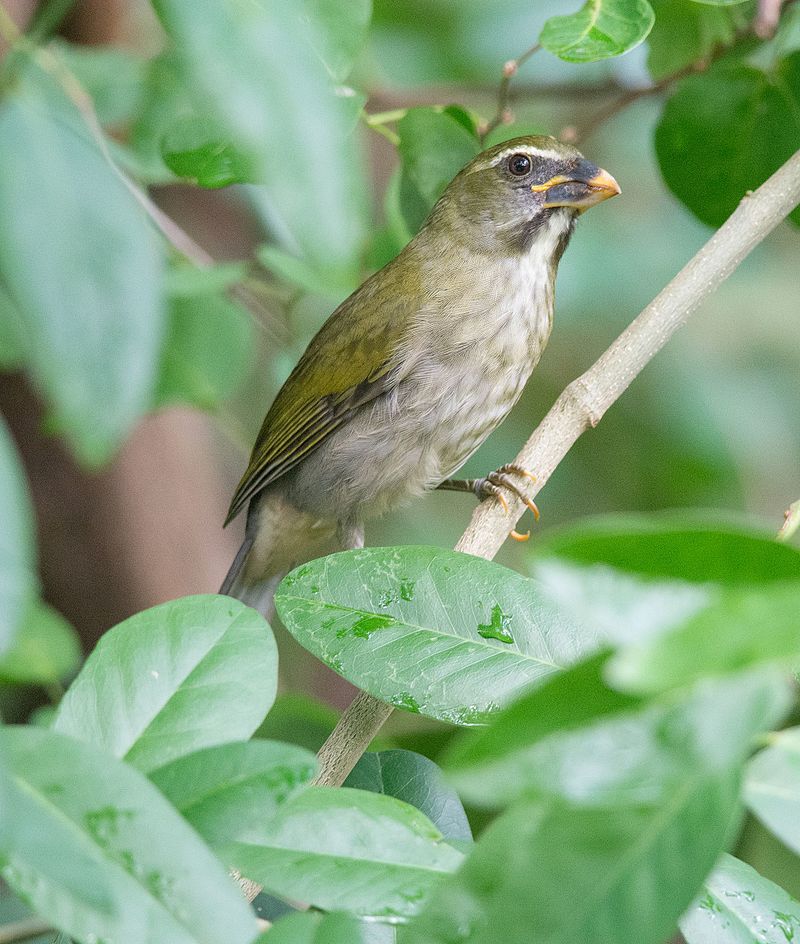
The Lesser Antillean saltator is a species of songbird found in Dominica, Martinique, Saint Kitts and Nevis, and Saint Lucia.
They live mainly in subtropical or tropical dry forests but can also be seen in heavily degraded former forest areas.
These birds have brown upperparts with blackish wings; their underparts are white to pale grey. They possess a thick bill which curves slightly downward at the tip.
Their diet consists mostly of insects such as beetles, flies and grasshoppers along with berries from trees like Miconia robinsoniana and Eugenia spicata that they forage for on the ground or lower branches within the canopy layer of these habitats.
The Lesser Antillean saltator plays an important role in controlling insect populations near its range making it crucial to maintain healthy ecosystems within this region.Scientific classification:
| Kingdom | Animalia |
| Phylum | Chordata |
| Class | Aves |
| Order | Passeriformes |
| Family | Thraupidae |
| Genus | Saltator |
| Species | S. albicollis |
20. Boobies
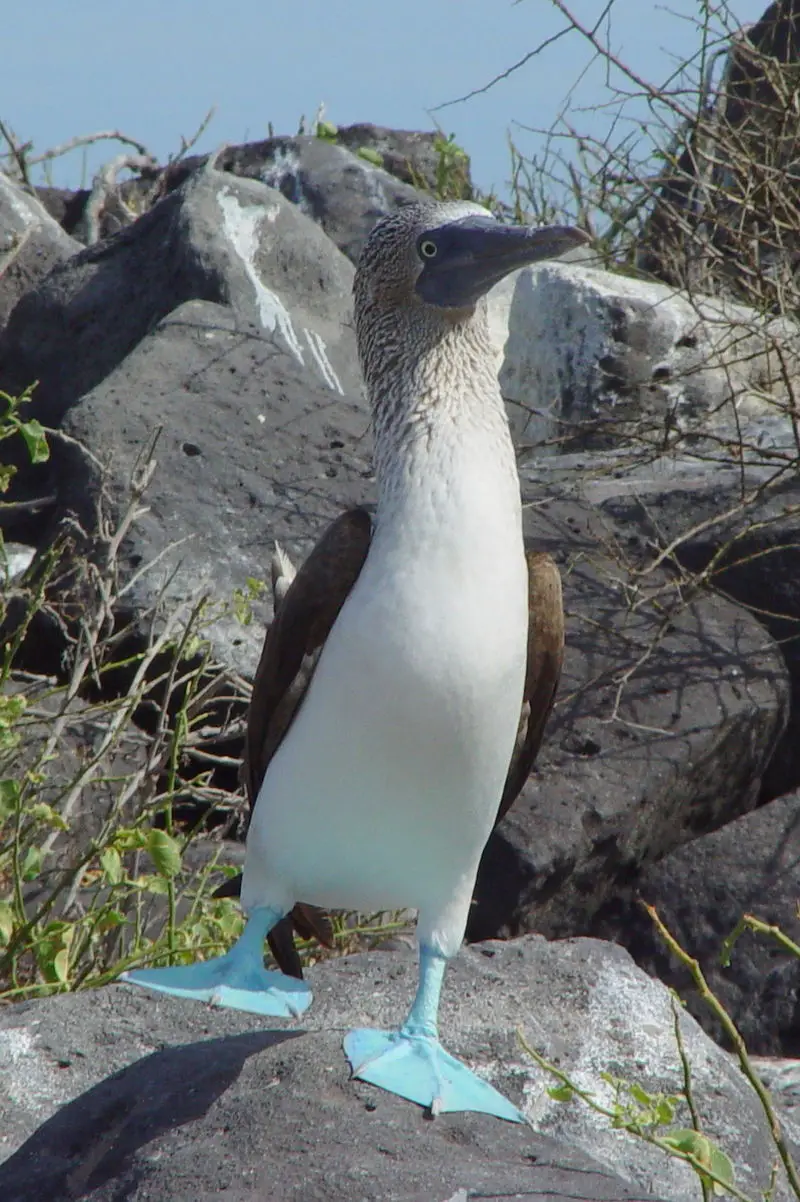
Boobies are seabirds from the family Sulidae. They were originally classified in the genus Sula, and are closely related to gannets (Morus).
Boobies get their name from the Old Norse term “súla,” which was used for another member of their family—the gannet.
These birds can be identified by their brown feathers, long wingspan, webbed feet and sharp bills that they use to catch fish.
Despite being clumsy on land due to their large size and small legs, boobies excel at flying over oceans where they hunt for food with great agility and grace.
Their powerful flaps help them dive quickly underwater as well.Scientific classification:
| Kingdom | Animalia |
| Phylum | Chordata |
| Class | Aves |
| Order | Suliformes |
| Family | Sulidae |
| Genus | Sula Brisson, 1760 |
21. Rufous Nightjar
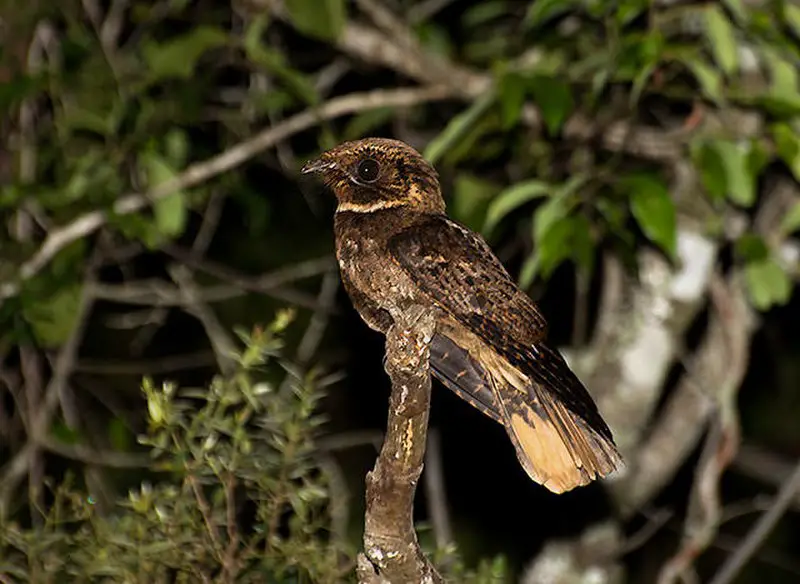
The Rufous Nightjar is a species of nightjar found in many countries across South America, including Argentina, Bolivia, Brazil and Colombia.
It has a distinctive rufous-brown plumage with white spots on its wings and tail feathers that help it to blend into the darkness at night.
Its diet consists mainly of insects which it captures during nocturnal hunting sessions. The Rufous Nightjar is known for its extraordinary vocalizations composed of various clicks and trills used as calls between pairs or when making territorial claims.
As well as being an interesting member of the avian world, this bird plays an important role in controlling insect populations while it searches for food.Scientific classification:
| Kingdom | Animalia |
| Phylum | Chordata |
| Class | Aves |
| Order | Caprimulgiformes |
| Family | Caprimulgidae |
| Genus | Antrostomus |
| Species | A. rufus |
22. Lesser Antillean Flycatcher
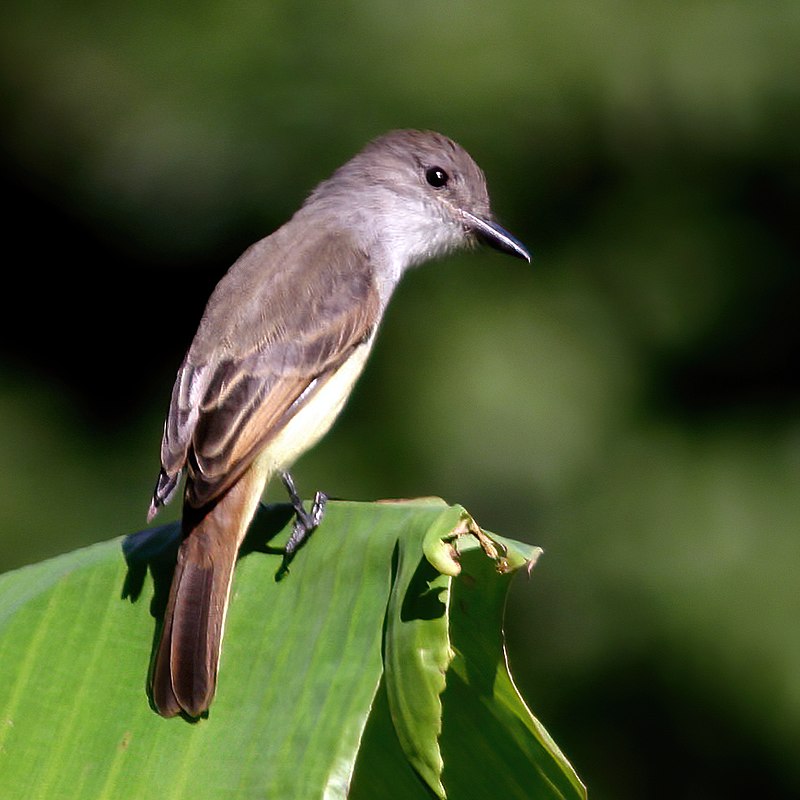
The Lesser Antillean flycatcher is a species of bird found in the Caribbean region. It belongs to the family Tyrannidae and inhabits subtropical or tropical moist lowland forests.
This small songbird has long wings, rounded heads, and short bills with distinct dark markings on its upperparts. Its diet consists mostly of insects which it catches by flying around branches and foliage looking for prey.
The Lesser Antillean flycatcher also builds its nest near tree trunks using twigs, leaves, feathers, grasses and bark strips as materials for construction.
Despite being widely distributed across several islands in the Caribbean Sea this species is considered vulnerable due largely to habitat destruction caused by human activities such as logging and urbanization throughout their range area.Scientific classification:
| Kingdom | Animalia |
| Phylum | Chordata |
| Class | Aves |
| Order | Passeriformes |
| Family | Tyrannidae |
| Genus | Myiarchus |
| Species | M. oberi |
23. Tropical Mockingbird
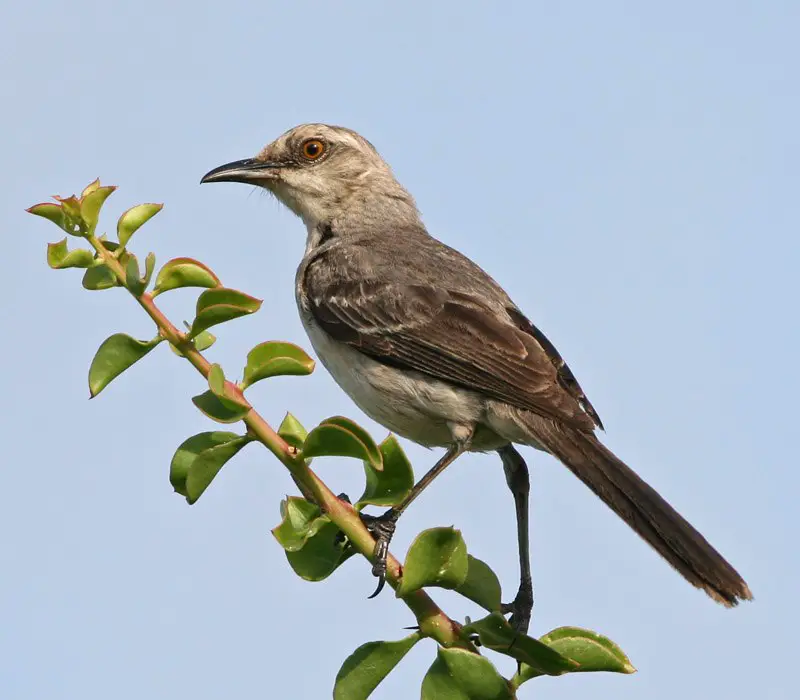
The Tropical mockingbird is a species of bird found throughout Central America and the Caribbean. It has been classified as a resident breeding bird, with its range stretching from southern Mexico to northern and eastern South America.
This species is closely related to the Northern Mockingbird, forming what is known as a superspecies between them both.
The Tropical mockingbird can be recognized by its grey-brown coloration on top, blending into white underparts which are highlighted by black spots along their throat and wings.
They have long legs for perching in trees or shrubs while searching for prey such as insects before singing out melodic songs during territorial disputes with other birds in the area.
Sadly, one subspecies -the San Cristobal Mockingbird – has been listed as critically endangered due to habitat destruction caused by human activities including logging within their natural environment.Scientific classification:
| Kingdom | Animalia |
| Phylum | Chordata |
| Class | Aves |
| Order | Passeriformes |
| Family | Mimidae |
| Genus | Mimus |
| Species | M. gilvus |
24. Threskiornithidae
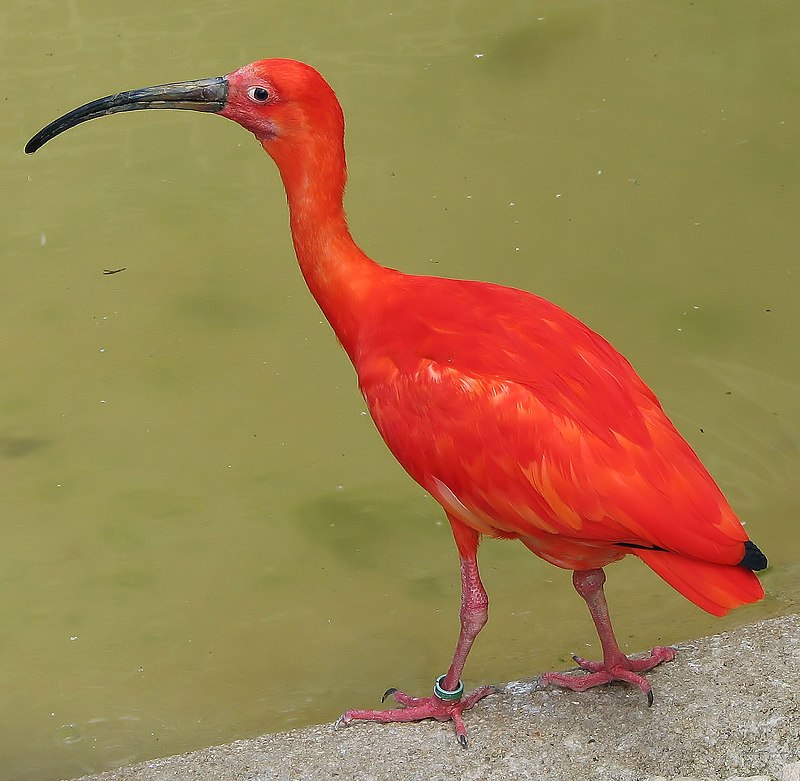
Threskiornithidae is a family of large wading birds which includes 36 species. These birds are traditionally divided into two subfamilies – the ibises and the spoonbills.
However, recent genetic analysis has shown that spoonbills actually belong to Old World ibis group, while New World ibises form an early offshoot from this lineage.
Threskiornithidse members have long curved beaks with serrated edges used for catching fish in shallow water or mudflats, as well as other aquatic invertebrates like crustaceans and mollusks.
They also feed on plant matter such as grains and seeds found close to wetlands areas where they live.
This diverse diet makes them important scavengers in their ecosystems, helping maintain healthy populations of native wildlife by controlling insect numbers and dispersing energy-rich seeds throughout wetland habitats.Scientific classification:
| Kingdom | Animalia |
| Phylum | Chordata |
| Class | Aves |
| Order | Pelecaniformes |
| Suborder | Ardei |
| Family | Threskiornithidae Richmond, 1917 |
25. Procellariidae
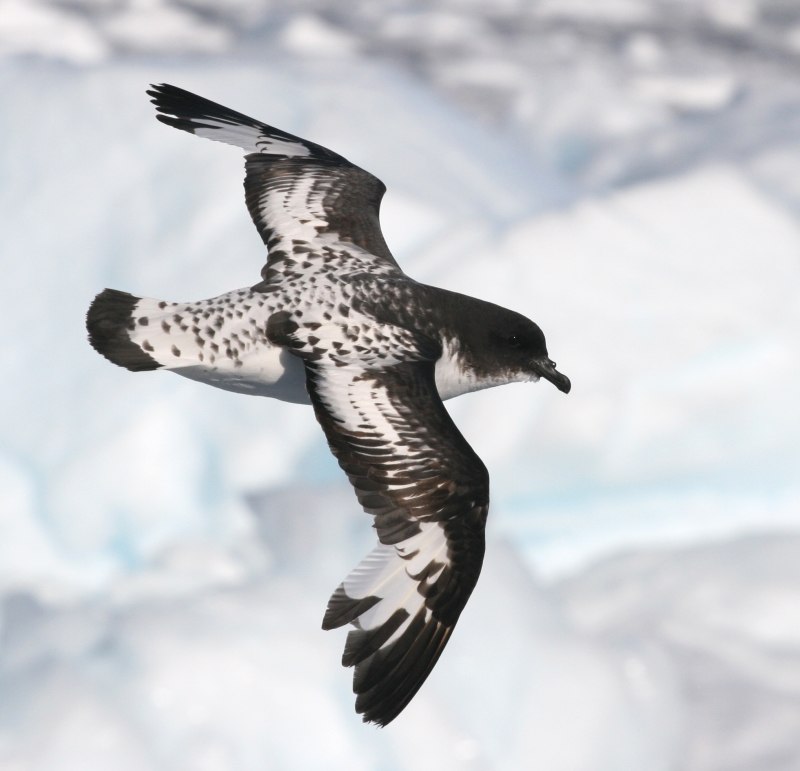
Procellariidae is a diverse family of seabirds belonging to the bird order Procellariiformes.
These birds are commonly referred to as tubenoses and include fulmarine petrels, gadfly petrels, diving petrels, prions, and shearwaters.
They range in size from the small storm-petrel which measures around 18cm long to the giant albatross which can reach up to 3 meters in length.
Generally found near oceans or coasts where they feed on fish as well as squid and other marine life depending on species.
Many procellariids will also nest inland during breeding season before returning back out at sea for most of their lives.
Their wings have specially adapted feathers that give them incredible gliding abilities allowing them literally fly with minimal effort over vast distances across oceanic regionsScientific classification:
| Kingdom | Animalia |
| Phylum | Chordata |
| Class | Aves |
| Order | Procellariiformes |
| Family | Procellariidae Leach, 1820 |
26. Plovers

Plovers are a family of around 64-68 species of ground-dwelling birds, commonly found in open country such as fields, meadows and tundras.
They have short bills with webbed feet to help them forage through mud or shallow water.
Plover plumage is usually mottled brown though some species may have brighter colors on the head and wings.
These birds feed mainly on insects but can also eat small crustaceans and worms.
Plovers breed during springtime when they dig holes in sandy or pebbled beaches to lay their eggs which hatch after about 3 weeks incubation period.
They use distraction display behaviour by pretending an injury to the predators away from their nests if needed for protecting their young ones.Scientific classification:
| Kingdom | Animalia |
| Phylum | Chordata |
| Class | Aves |
| Order | Charadriiformes |
| Family | Charadriidae Leach, 1820 |
27. Neotropic Cormorant
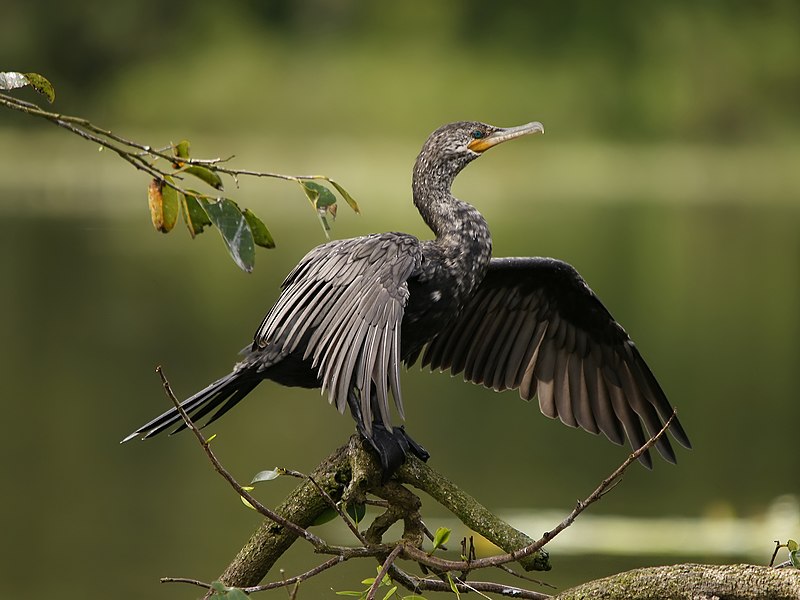
The Neotropic Cormorant, also known as the Olivaceous Cormorant, is a medium-sized bird found in tropical and subtropical regions of Central America, South America and the United States.
It can be identified by its black body with bright yellow facial skin on both sides of its large bill. The tail feathers are short and squared off at the tip.
This species breeds mainly on coasts but will sometimes nest inland near rivers or lakes during certain parts of their life cycle.
They feed mostly on small fish caught while diving underwater but can also eat crustaceans, amphibians and insects.
These birds roost in trees at night to keep safe from predators like foxes which prey upon them when they sleep close to water sources during daylight hours.Scientific classification:
| Kingdom | Animalia |
| Phylum | Chordata |
| Class | Aves |
| Order | Suliformes |
| Family | Phalacrocoracidae |
| Genus | Nannopterum |
| Species | N. brasilianum |
28. Bee-Eater

Bee-eaters are one of the most beautiful and vibrant birds in existence. They have a slender body, long wings, down turned bills and their signature elongated central tail feathers which make them instantly recognizable from afar.
Their plumage is incredibly colorful with many shades ranging from blues to greens to reds that glisten when they fly through the air.
These stunning creatures can be found all over Africa, Asia, Southern Europe, Australia and New Guinea where they feed mainly on bees but also other insects like flies or wasps as well as small mammals such as lizards or rodents.
Bee-eaters live in colonies near rivers or wetlands so that they may easily hunt for food while staying close together for safety purposes.
Additionally it allows them to better display their impressive courtship dances during mating season.Scientific classification:
| Kingdom | Animalia |
| Phylum | Chordata |
| Class | Aves |
| Order | Coraciiformes |
| Family | Meropidae Rafinesque, 1815 |
29. Scaly-Naped Pigeon
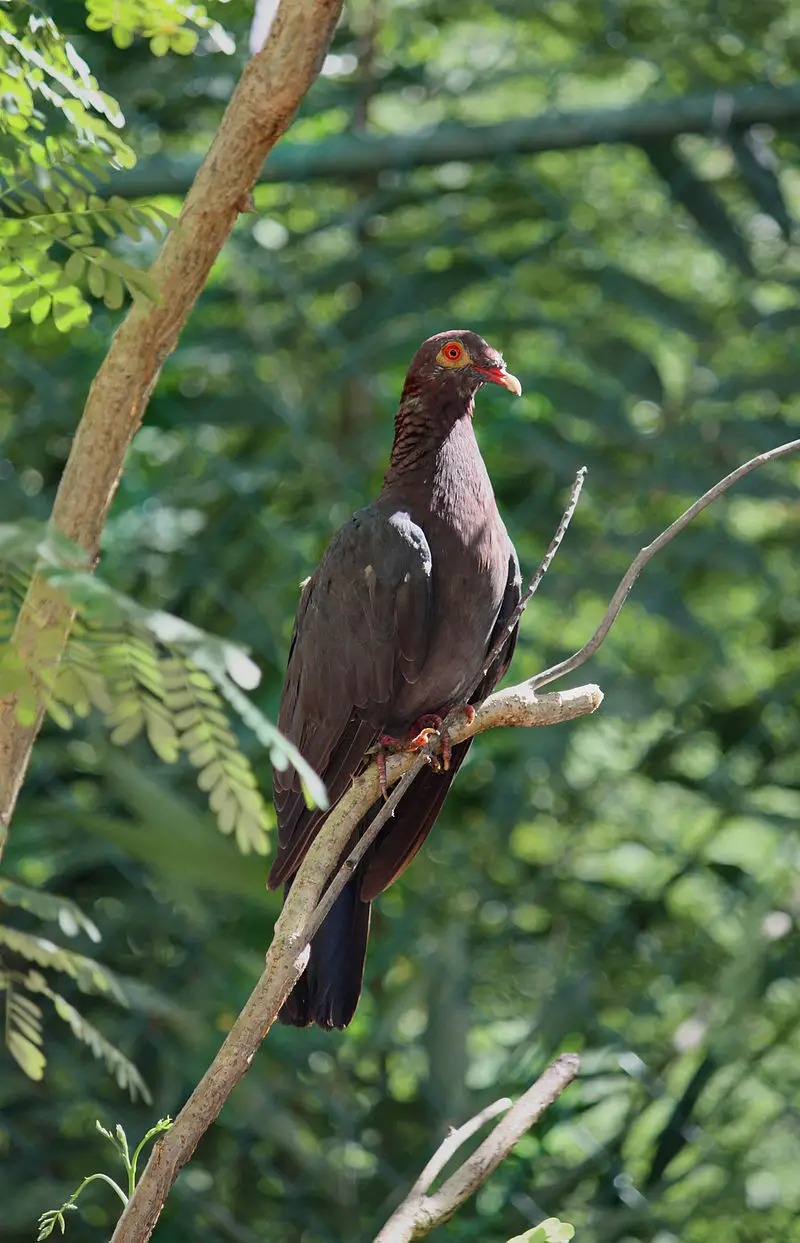
The scaly-naped pigeon is a large bird belonging to the family Columbidae. It has slate grey plumage with maroon coloured feathers around its neck, giving it the common name of red-necked pigeon.
The species originates from throughout the Caribbean and can reach 14–16 inches in length.
Its scientific name is derived from its unique feature: small scales on its nape which form an attractive pattern when viewed up close.
This makes them easily distinguishable from other birds within their range as they are one of few that have this characteristic.
They feed mainly on fruit but also consume seeds, insects and even carrion depending on availability at any given time of year or location.Scientific classification:
| Kingdom | Animalia |
| Phylum | Chordata |
| Class | Aves |
| Order | Columbiformes |
| Family | Columbidae |
| Genus | Patagioenas |
| Species | P. squamosa |
30. Bridled Quail-Dove
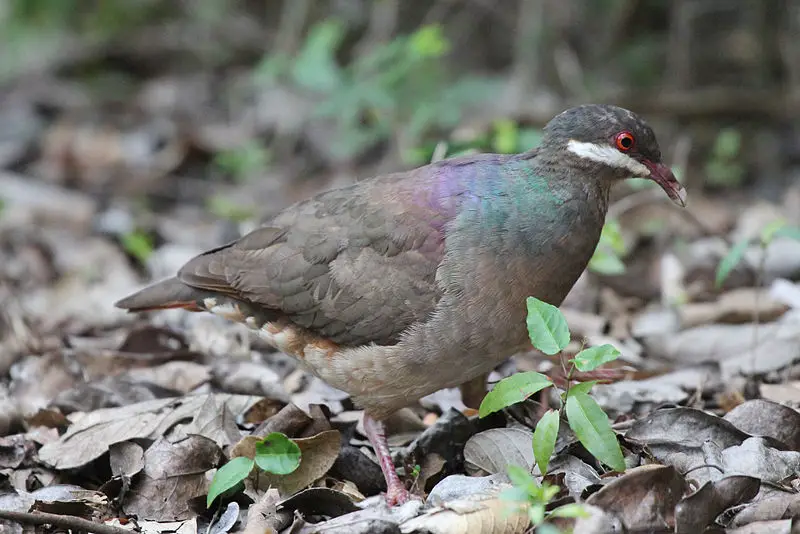
The Bridled Quail-Dove is a species of bird in the Columbidae family, found from Saint Lucia to Puerto Rico. It is monotypic, and it has been suggested that it forms a superspecies with Key West Quail-Doves.
Its mean weight varies between islands; generally being quite small at 93–128 g (3.3–4.5 oz).
They have distinctly barred heads and greyish white underparts with some dark barring on their backs, wings and tails – giving them an overall ‘bridled’ look for which they are named after.
In addition to this striking appearance they make deep cooing sounds whilst perched or hunting for food on the ground – particularly during breeding season when males compete against each other by singing different variations of their call simultaneously.Scientific classification:
| Kingdom | Animalia |
| Phylum | Chordata |
| Class | Aves |
| Order | Columbiformes |
| Family | Columbidae |
| Genus | Geotrygon |
| Species | G. mystacea |
31. Caribbean Elaenia
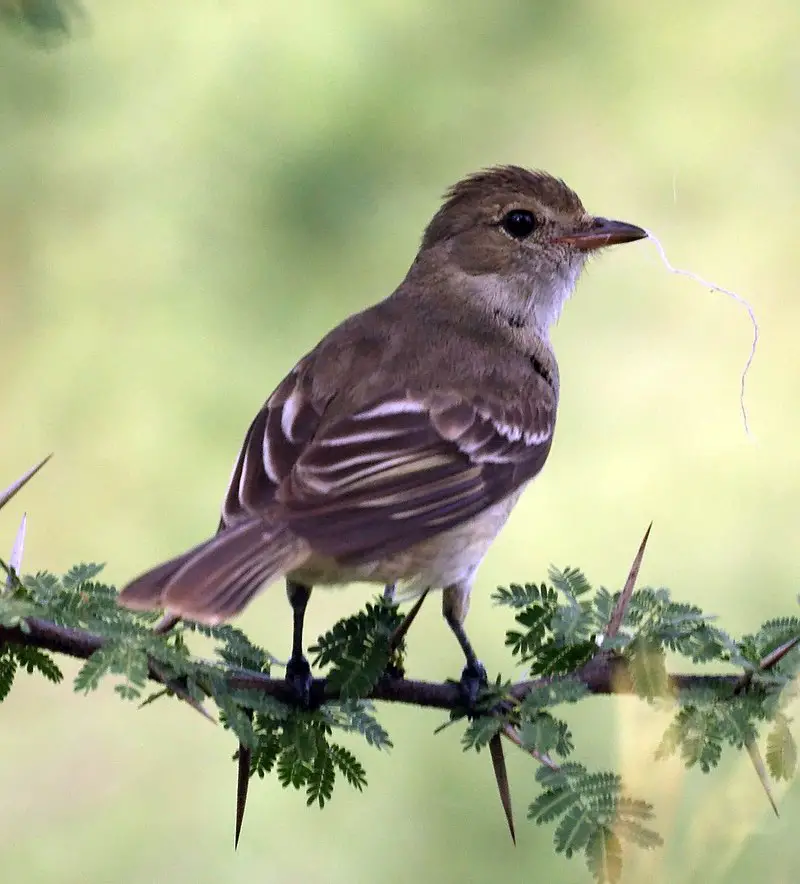
The Caribbean elaenia is a species of small bird that can be found in the West Indies and parts of Central America.
It is part of the Tyrannidae family and inhabits tropical dry broadleaf forests, subtropical or tropical moist lowland forests, as well as heavily degraded former forest areas.
In 1760, French zoologist Mathurin Jacques Brisson provided an extensive description on this species which has helped us gain further knowledge about it today.
The Caribbean elaenia typically measures around 6-9 inches long with predominantly olive green feathers with yellowish edges to some wings and tails.
They have white throats but lack any distinctive markings on their chest unlike many other birds from its family.
This bird feeds primarily on insects such as grasshoppers collected from trees or bushes while also consuming fruit when available during certain times of year.Scientific classification:
| Kingdom | Animalia |
| Phylum | Chordata |
| Class | Aves |
| Order | Passeriformes |
| Family | Tyrannidae |
| Genus | Elaenia |
| Species | E. martinica |
32. Audubon’s Shearwater
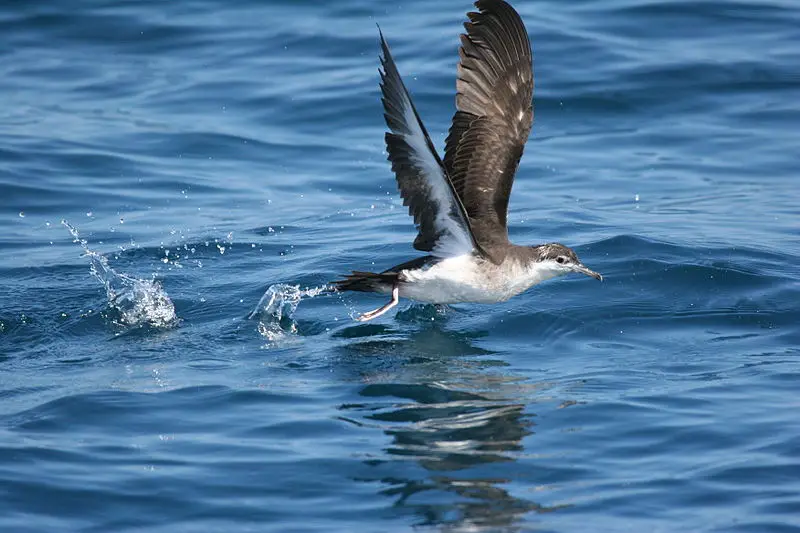
Audubon’s shearwater is a type of seabird belonging to the petrel family. It has many different monikers, including Baillon’s shearwater, tropical shearwater, Bannerman’s shearwater, Mascarene shearwater and Persian Sheawater.
This species was first discovered by French naturalist F�lix Louis L’Herminier in 1836 and earned its scientific name (Puffinus lherminieri) in his honour.
These birds are found throughout tropical oceans across the world from Africa to Asia and even Hawaii.
They have dark brown back feathers with white bellies which help them blend into their environment for protection against predators.
Audubon�s Sheerwaters feed on small fish near ocean surfaces or dive deep underwater when necessary due to their strong wings allowing them excellent swimming capabilities through powerful winds at sea level as well as incredible endurance during long distance flights over vast areas of open water around islands or coastlines.Scientific classification:
| Kingdom | Animalia |
| Phylum | Chordata |
| Class | Aves |
| Order | Procellariiformes |
| Family | Procellariidae |
| Genus | Puffinus |
| Species | P. lherminieri |
33. Zenaida Dove
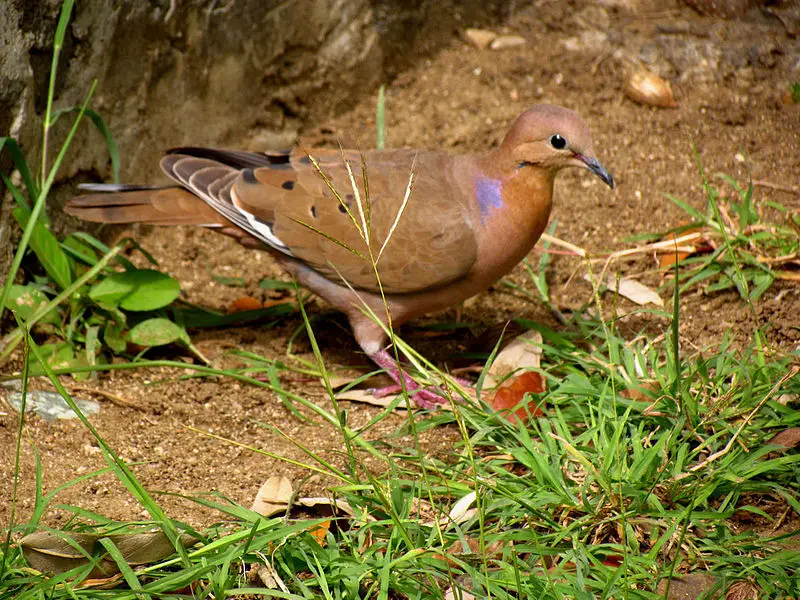
The Zenaida dove is a species of doves and pigeons found mainly in the Caribbean, but also parts of Mexico, Central America and South America.
With its distinct dark coloring, short rounded tail and an average length of 28-30 cm (11-12 inches), it stands out from other bird families.
It’s recognized as the national bird for Anguilla where locals refer to it as ‘turtle dove’. They are seen flying around open grasslands or roosting on tree branches close by populated areas.
These birds feed mostly on seeds that they pick off the ground while walking through fields.
The Zenaida Dove breeds all year round producing two broods during spring and summer months with both male and female taking turns incubating eggs over a span of 14 days before hatching into chicks.Scientific classification:
| Kingdom | Animalia |
| Phylum | Chordata |
| Class | Aves |
| Order | Columbiformes |
| Family | Columbidae |
| Genus | Zenaida |
| Species | Z. aurita |
34. Green-Throated Carib
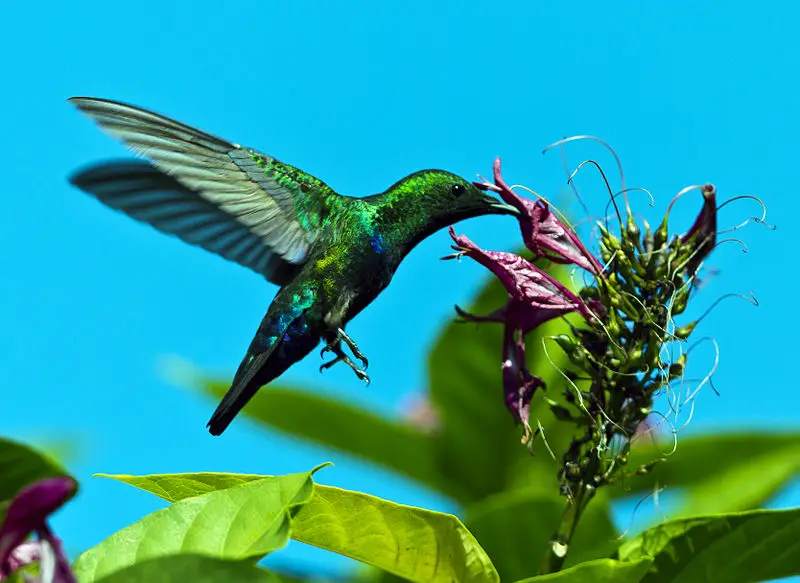
The Green-throated Carib is a species of hummingbird found in Puerto Rico and most of the Lesser Antilles. It was described by Swedish naturalist Carl Linnaeus in 1758.
The bird has distinctive green throat feathers, with iridescent blue on its back and wings. Its tail feathers are blackish brown at the base and white towards the tip, forming two distinct bands across their length.
This beautiful creature usually feeds on nectar from flowers or small insects such as spiders, bees and ants that it catches while flying through foliage.
Despite being fairly common throughout its range, this delightful little bird faces some threats due to habitat loss caused by human activity like agriculture or development projects taking place in areas where they live naturally.Scientific classification:
| Kingdom | Animalia |
| Phylum | Chordata |
| Class | Aves |
| Order | Apodiformes |
| Family | Trochilidae |
| Genus | Eulampis |
| Species | E. holosericeus |
35. Carib Grackle
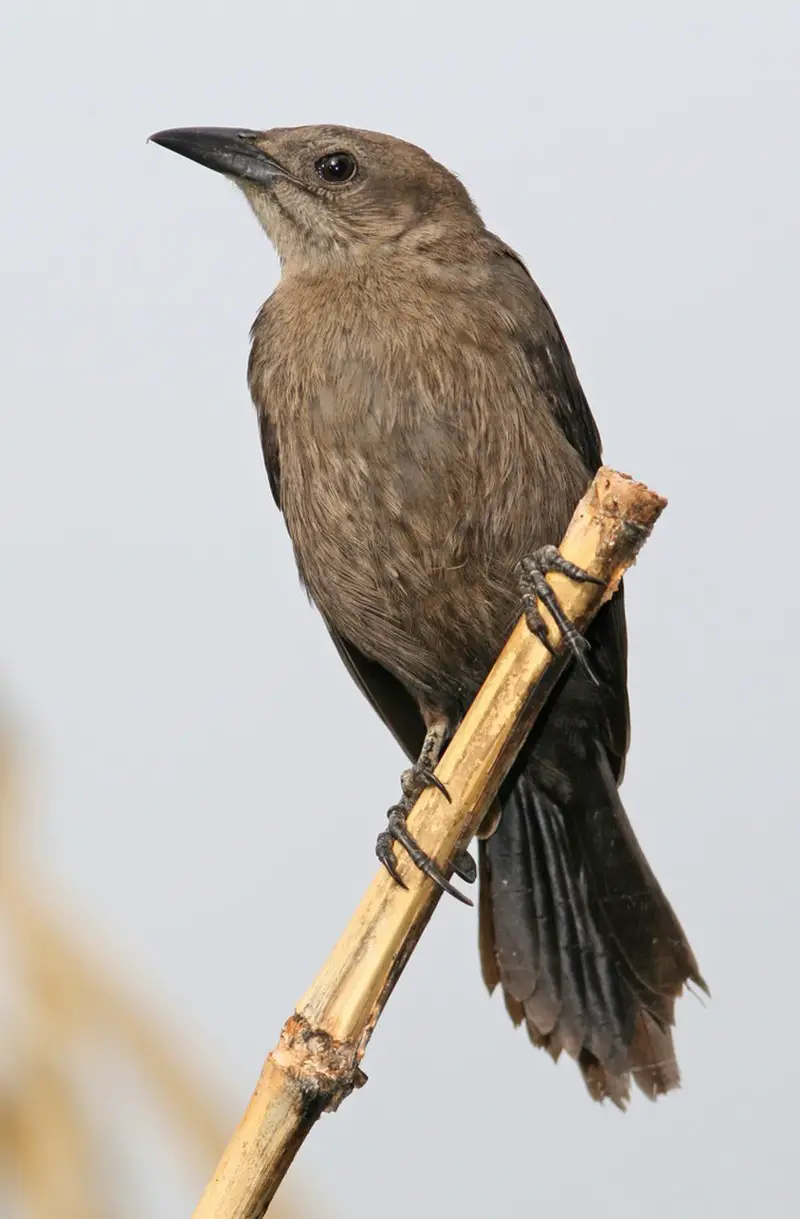
The Carib grackle is a tropical blackbird found in the Lesser Antilles and northern South America. It has eight subspecies, with the most widespread being Q. l. lugubris which can be found on Trinidad and much of mainland South America.
This particular subspecies was introduced to Puerto Rico during the 19th century where it now thrives due to its adaptability and tolerance towards human activity such as living near grazing animals or around farms.
Its diet consists mainly of small invertebrates, fruits, seeds and grains – all readily available in populated areas making it ideal for urban environments too.
They are also known for their beautiful songs used by males during breeding season to attract females but unfortunately this doesn’t last long as they generally only mate once throughout life before moving onto find another partner shortly after nesting season ends.Scientific classification:
| Kingdom | Animalia |
| Phylum | Chordata |
| Class | Aves |
| Order | Passeriformes |
| Family | Icteridae |
| Genus | Quiscalus |
| Species | Q. lugubris |
36. Spectacled Thrush
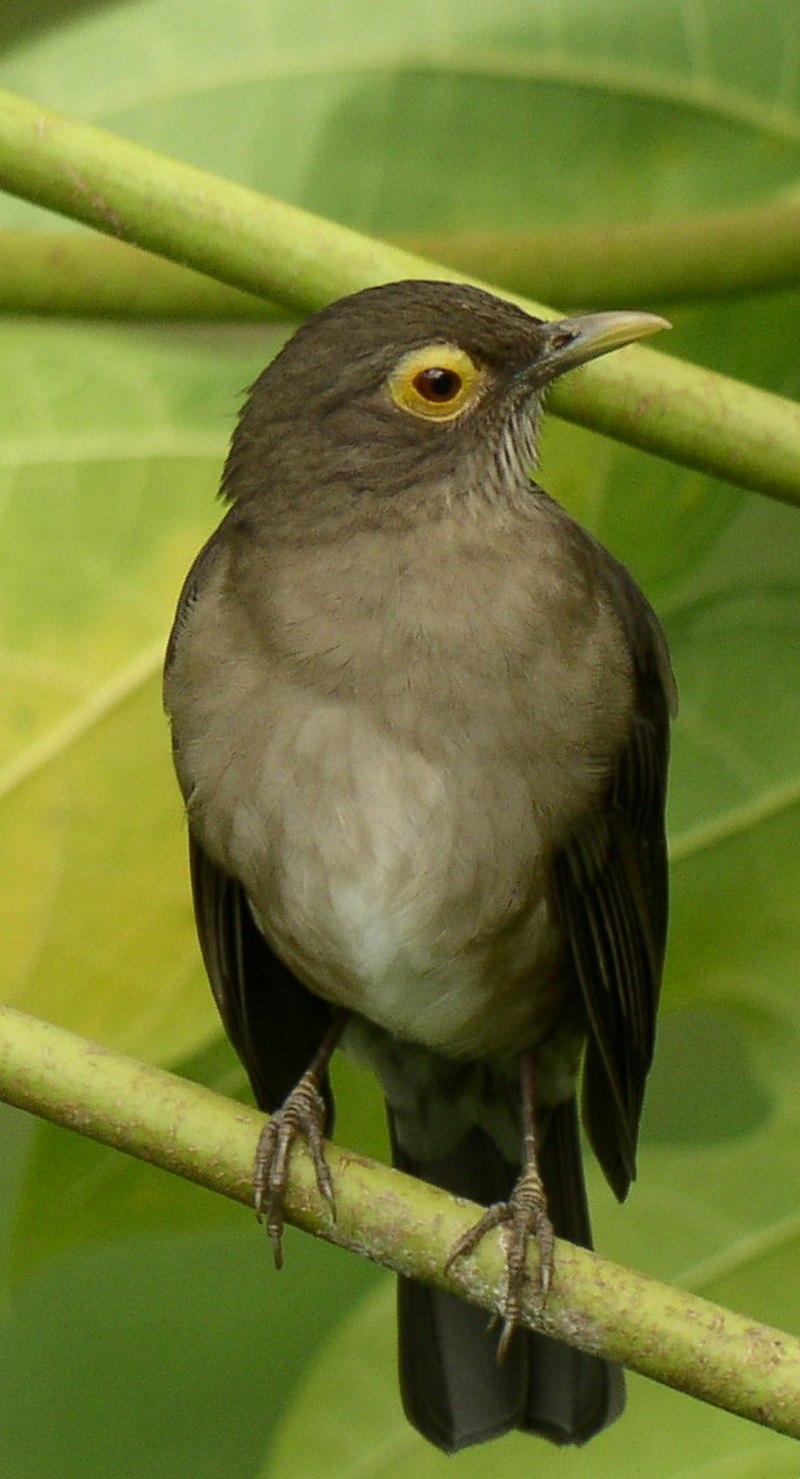
The Spectacled Thrush is a bird that can be found in the Lesser Antilles and South America from Colombia to Brazil. In Trinidad and Tobago, it’s known as Big-eye Grieve.
It was once thought to be related to another species called Ecuadorian thrush but they are now classified separately. The Spectacled Thrush has yellow eyes with white spectacles around them, hence its name.
Its plumage is mainly brownish grey on top while being paler underneath with streaks of black markings across both sides of its body.
This bird typically feeds on fruits and insects, making it an omnivore by nature.
They also love bathing in water pools or streams during hot days which makes for some great sightings if you’re lucky enough.
All in all, the Spectacled Thrush plays an important role in our environment so their conservation should definitely not be overlooked.Scientific classification:
| Kingdom | Animalia |
| Phylum | Chordata |
| Class | Aves |
| Order | Passeriformes |
| Family | Turdidae |
| Genus | Turdus |
| Species | T. nudigenis |
37. Scaly-Breasted Thrasher
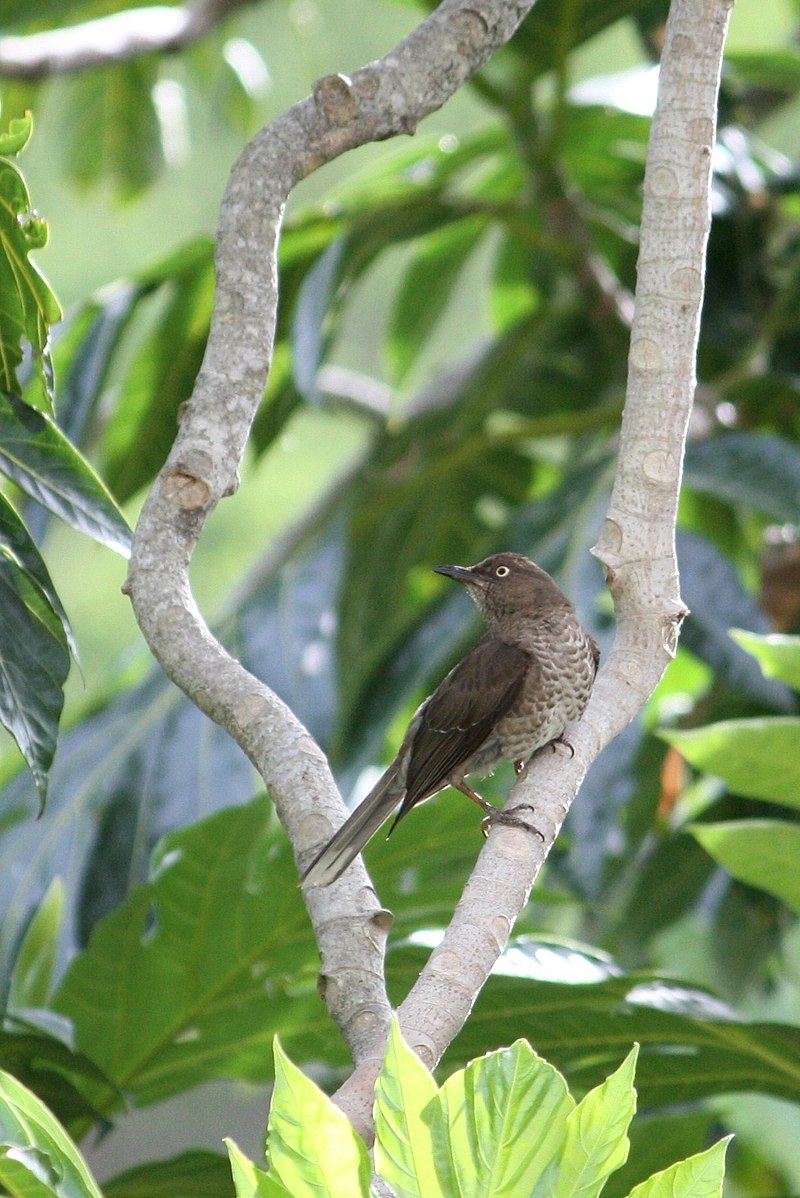
The Scaly-breasted Thrasher is a species of bird in the family Mimidae, found throughout much of the Lesser Antilles.
It has five subspecies and is approximately 23 cm long with greyish brown upperparts and black wings marked with white spots.
Its underparts are reddish orange to yellow buff, finely scaled or scalloped with darker edges, giving it its name.
This thrasher feeds mainly on insects but also eats fruits and berries as well as small lizards.
The male performs elaborate courtship displays which include soaring flights high into the air followed by singing from perches at the tops of trees or shrubs during breeding season between February – May period each year .
It typically nests low down in thickets near water sources such as rivers or streams using twigs bound together with spider web silk for nesting material , laying 2 to 3 eggs at one time.
The Scaly-breasted Thrashers are overall common birds that inhabit various habitats including mangroves, rainforests and dry scrublands across their range making them an important part of local ecosystems within their range.Scientific classification:
| Kingdom | Animalia |
| Phylum | Chordata |
| Class | Aves |
| Order | Passeriformes |
| Family | Mimidae |
| Genus | Allenia Cory, 1891 |
| Species | A. fusca |
38. Brown Trembler
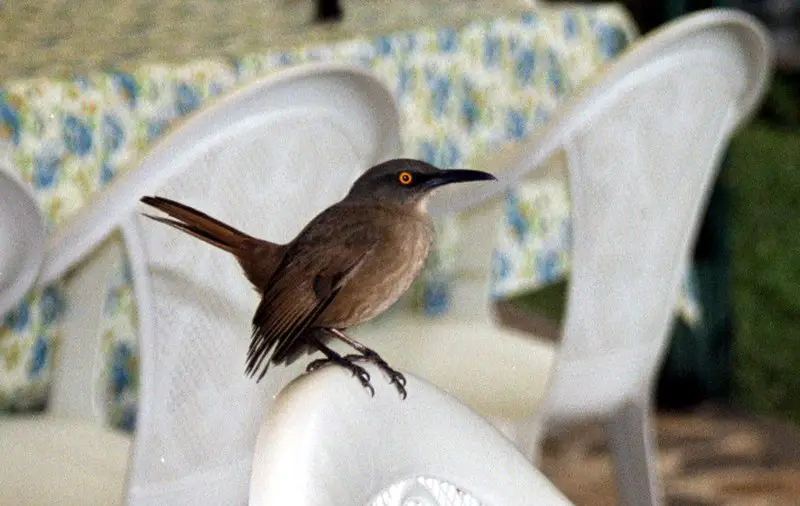
The Brown Trembler (Cinclocerthia Ruficauda) is a species of bird in the Mimidae family, which includes mockingbirds and thrashers. It can be found on seven Caribbean islands: Saba, St.
Kitts, Nevis, Montserrat, Guadeloupe, Dominica and St. Vincent. This bird has an olive-brown back with white underparts and unique tail feathers that quiver when perched or flying low over vegetation – hence its name.
The International Ornithological Committee recognizes nine subspecies due to slight variations between each island population; however further research is needed as some taxonomists believe there are more distinct populations within this species’ range.
Despite limited information about their ecology we do know they primarily feed on fruit from shrubs such as lignum vitae trees while foraging near ground level among tall grasses in open areas like pastures or coastal scrubland habitats.Scientific classification:
| Kingdom | Animalia |
| Phylum | Chordata |
| Class | Aves |
| Order | Passeriformes |
| Family | Mimidae |
| Genus | Cinclocerthia |
| Species | C. ruficauda |
39. Black-Faced Grassquit
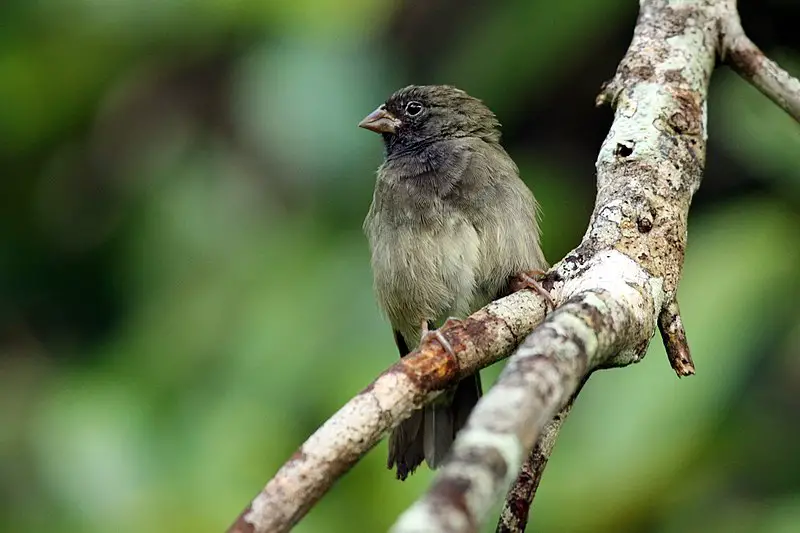
The Black-faced grassquit is a small bird belonging to the tanager family, genetically related to Darwin’s finches. It breeds mainly in the West Indies and along certain parts of Colombia and Venezuela.
The Swedish naturalist Carl Linnaeus first formally described it back in 1766 as part of his twelfth edition work on species classification.
This type of bird has a black head with white spots around its eyes, grey wings and tail feathers; its body is brownish orange or yellow with darker shades towards the belly area.
Its diet consists mostly of seeds from grasses but may also include other insects for additional nutrition during breeding season.Scientific classification:
| Kingdom | Animalia |
| Phylum | Chordata |
| Class | Aves |
| Order | Passeriformes |
| Family | Thraupidae |
| Genus | Melanospiza |
| Species | M. bicolor |
40. Stilt Sandpiper
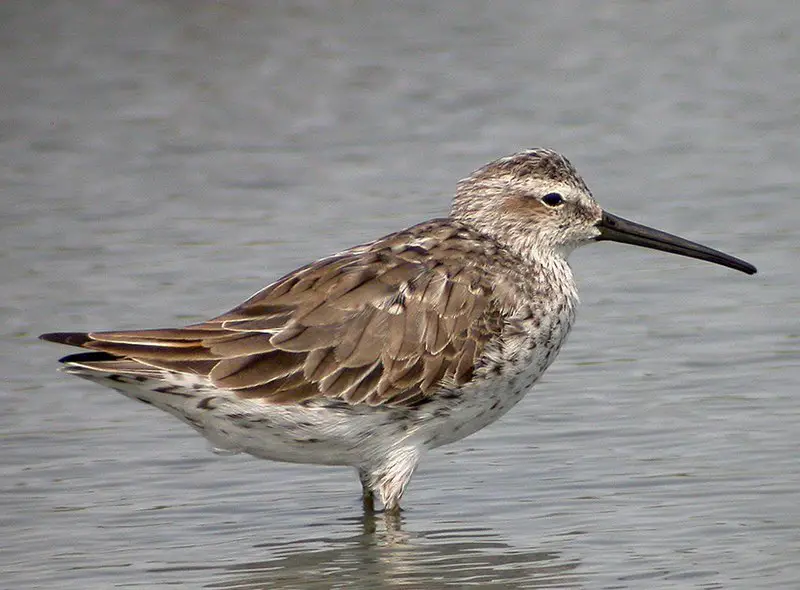
The Stilt Sandpiper (Calidris himantopus) is a small shorebird with ancient Greek origins. It has grey-coloured feathers, and its scientific name is derived from the terms “strap foot” or “thong foot”.
This bird bears some resemblance to smaller calidrid sandpipers, also known as ‘stints’. Through recent DNA sequence information, it was found that this species of birds are closely related to other wading shorebirds such as curlews and godwits.
They can usually be seen along the edges of rivers and creeks in shallow waters where they feed on aquatic insects like beetles, flies, mayflies etc., which makes them an important part of their ecosystem’s food chain.
The stilt sandpiper population appears to have been stable over time but further research needs to be done in order for us to understand more about this unique species.Scientific classification:
| Kingdom | Animalia |
| Phylum | Chordata |
| Class | Aves |
| Order | Charadriiformes |
| Family | Scolopacidae |
| Genus | Calidris |
| Species | C. himantopus |
Also Featured In: Common Northwest Territories Birds, Most Common Oaxaca Birds
41. American Black Swift
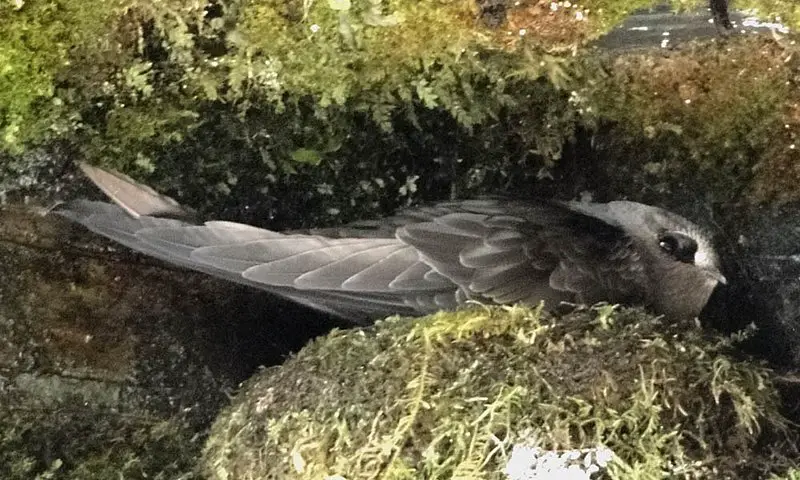
The American black swift is a species of bird that resides in North America, Central and South America as well as the Caribbean.
It was formally described by German naturalist Johann Friedrich Gmelin in 1789.
These birds prefer high mountain regions, living near fast-flowing streams or waterfalls with plenty of insects for food.
They have long wings which allow them to soar up on thermals and catch insects midair.
As their name suggests, they are almost entirely black with some lighter feathers around the neck area giving it an overall glossy look when seen from below.
Their breeding season takes place between May-August where both parents take part in caring for the young until they can fly independently after about 6 weeks old.Scientific classification:
| Kingdom | Animalia |
| Phylum | Chordata |
| Class | Aves |
| Order | Apodiformes |
| Family | Apodidae |
| Genus | Cypseloides |
| Species | C. niger |
42. Pearly-Eyed Thrasher
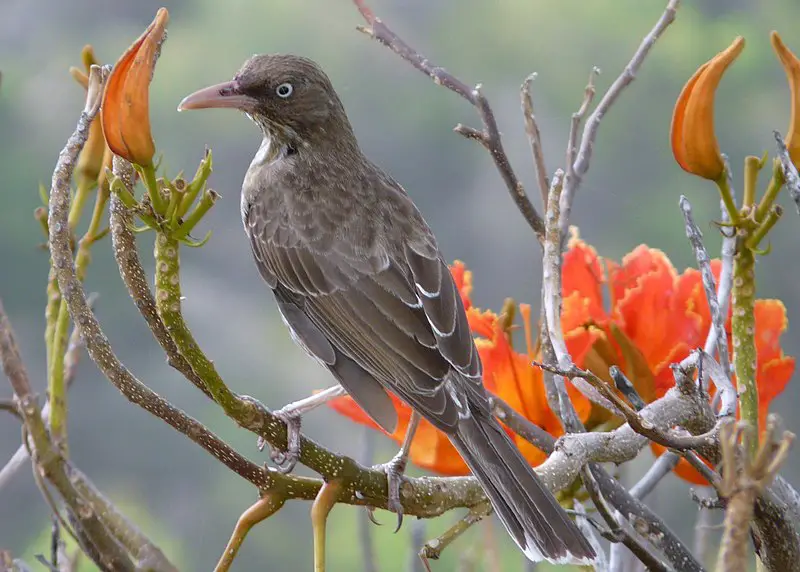
The Pearly-eyed Thrush is a unique and beautiful bird native to the Caribbean islands. It has stunning pearly eyes, with white patches on its wings and tail.
This thrasher measures up to 28-30 cm in length, making it the largest species of Mimidae family found in this area.
With an isolated subspecies living on Bonaire island, these birds have adapted well to their environment over time.
They feed mainly on insects found around them, but will also eat fruits or berries when available for extra nourishment.
These birds are often seen singing together as part of group displays at dawn or dusk – one more reason why they are so special.Scientific classification:
| Kingdom | Animalia |
| Phylum | Chordata |
| Class | Aves |
| Order | Passeriformes |
| Family | Mimidae |
| Genus | Margarops P.L. Sclater, 1859 |
| Species | M. fuscatus |
43. Caribbean Martin
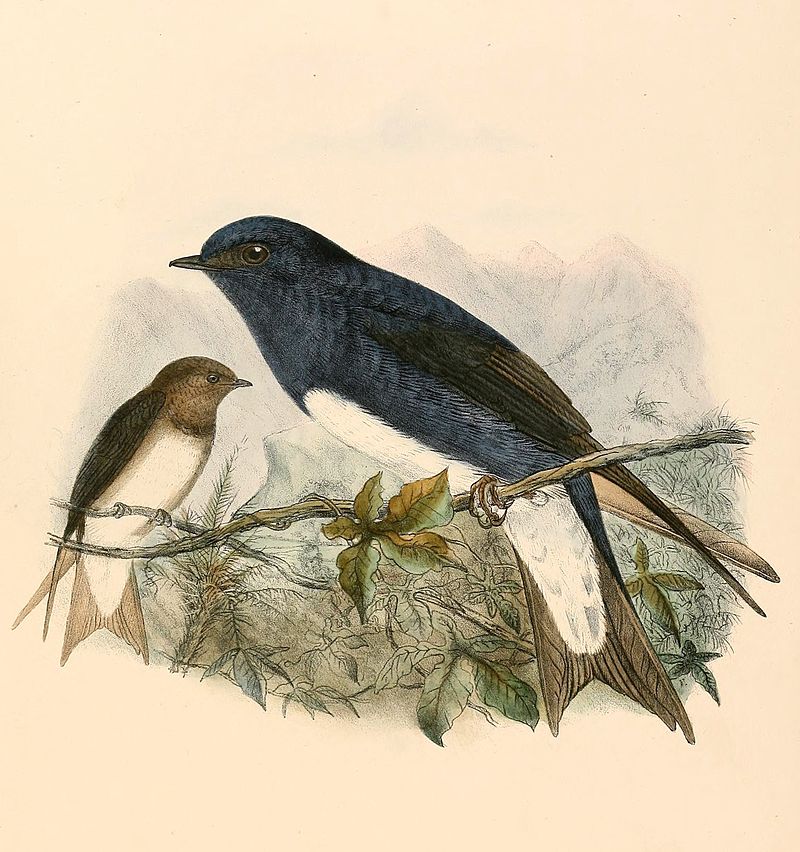
The Caribbean martin is a large swallow that can be found throughout the Caribbean, except on Cuba and Isla de la Juventud.
It has at various times been thought to be related to the purple martin but more recently it has been recognised as its own species – Progne dominicensis.
This species is closely related to both the Cuban martin (P. cryptoleuca) and South American martins (S. chirica).
The adult birds have predominantly white underparts with grey-brown upper parts and black wings.
Their tail feathers are forked in shape making them very distinctive when flying through their habitats of open woodlands, savannas or mangroves near bodies of water such as lakes or rivers where they feed mainly on insects like dragonflies or termites.Scientific classification:
| Kingdom | Animalia |
| Phylum | Chordata |
| Class | Aves |
| Order | Passeriformes |
| Family | Hirundinidae |
| Genus | Progne |
| Species | P. dominicensis |
Also Featured In: Common Birds of Turks and Caicos Islands,
44. Grassland Yellow Finch
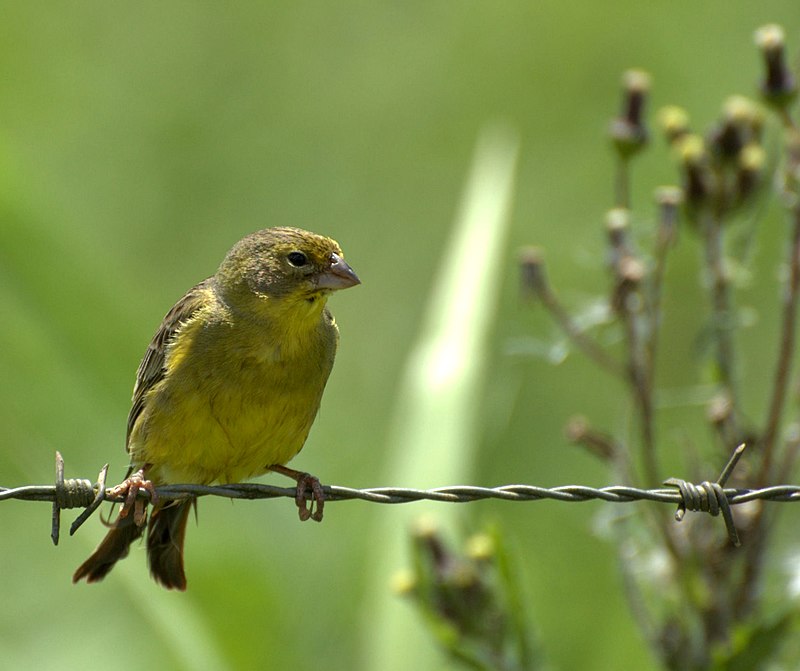
The Grassland yellow finch is a small passerine bird that belongs to the tanager family, despite its name.
It can be found in tropical South America from Colombia south and eastwards including parts of central Ecuador, Peru and Brazil.
This species typically resides year round though some birds have been known to migrate further north during winter months.
These birds feed mainly on seeds which they forage from grasses while also consuming insects such as beetles or flies when available.
The plumage of this beautiful bird consists of shades ranging from olive-green to yellow with black streaks running along its wings and tail feathers; males may possess brighter colors than females depending on the season.
Overall these stunning little creatures make wonderful additions to any aviary setting.Scientific classification:
| Kingdom | Animalia |
| Phylum | Chordata |
| Class | Aves |
| Order | Passeriformes |
| Family | Thraupidae |
| Genus | Sicalis |
| Species | S. luteola |
45. Black-Whiskered Vireo
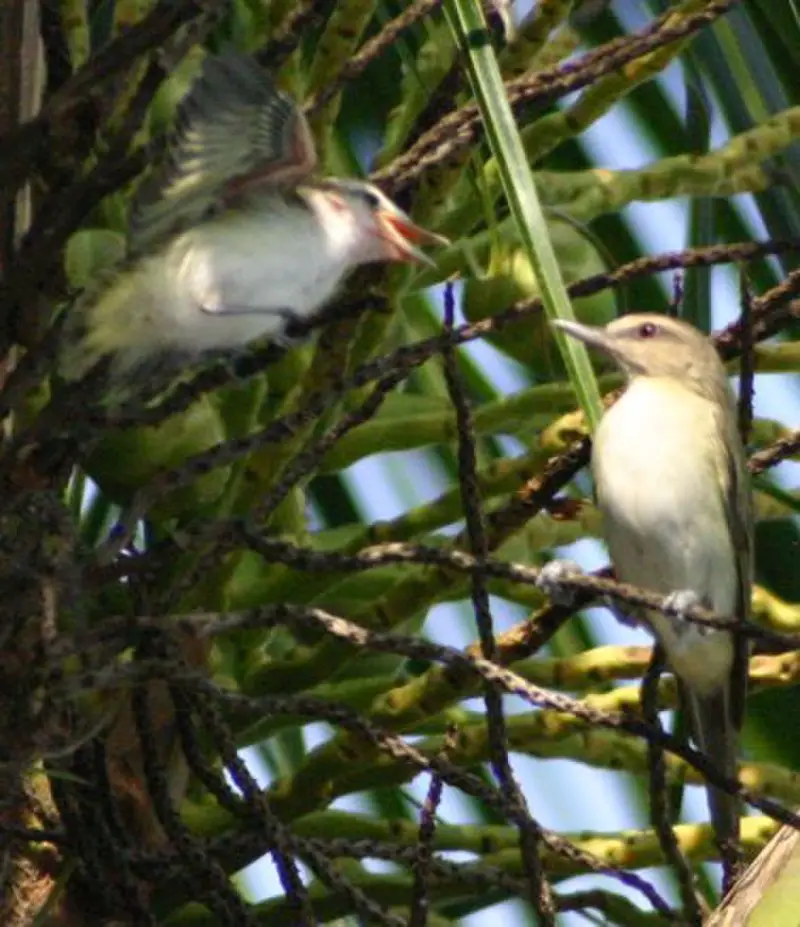
The black-whiskered vireo is a small passerine bird, found in the southern United States, West Indies and northern South America.
It breeds mainly in open deciduous wooded areas but has been known to be an occasional vagrant to Costa Rica.
This species migrates partially north during its winter season from Greater Antilles up towards northern parts of South America.
The male can easily be identified by his distinctive black whiskers on either side of its face while females are generally duller with white streaks along their wings and back.
They make nests at mid tree levels usually out of twigs, grasses or strips of bark which they line with finer materials like feathers or fur for insulation purposes.
All in all these birds are delightful additions to any habitat where they inhabit.Scientific classification:
| Kingdom | Animalia |
| Phylum | Chordata |
| Class | Aves |
| Order | Passeriformes |
| Family | Vireonidae |
| Genus | Vireo |
| Species | V. altiloquus |
46. Ruddy Quail-Dove
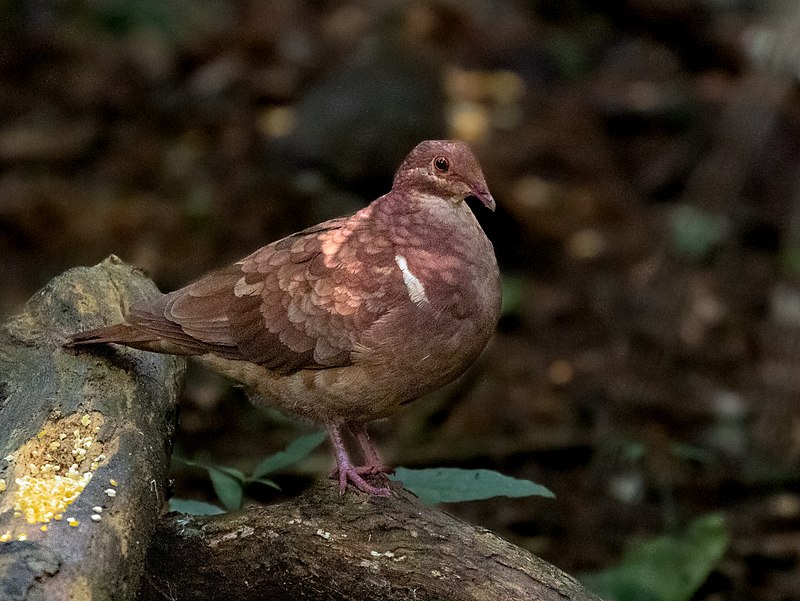
The Ruddy Quail-Dove is a beautiful bird native to the West Indies, Central and South America. It has a reddish brown plumage with dark spots on the wings and neck that give it an attractive appearance.
Its size ranges from 19–28 cm in length. The dove builds its nest either on shrubs or sometimes directly on the ground, laying two buff-colored eggs as part of their breeding cycle.
In recent years, there have been sightings of this species as far north as Florida and Texas proving just how resilient these birds are.
They feed mainly upon fruits found in woodland areas but also consume small invertebrates at times too.
All in all, this stunningly colored creature makes for an amazing addition to any environment they inhabit.Scientific classification:
| Kingdom | Animalia |
| Phylum | Chordata |
| Class | Aves |
| Order | Columbiformes |
| Family | Columbidae |
| Genus | Geotrygon |
| Species | G. montana |
Also Featured In: Most Common Birds Found in Nayarit,
47. Pewees
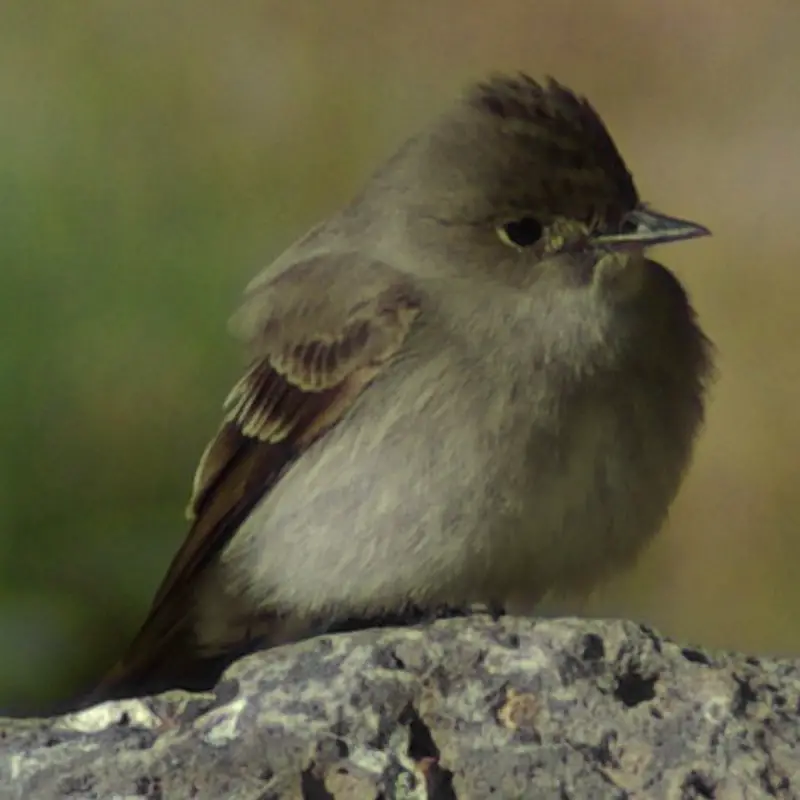
Pewees are birds from the genus Contopus, part of the Tyrant flycatcher family Tyrannidae. They have a charcoal-grey colour with wing bars, and usually live in wooded areas.
Pewees got their name from one of its members’ call; they tend to be small to medium sized insect eaters. Jean Cabanis introduced this genus back in 1855 with the eastern pewee being its type species.
These birds can mainly be found across North and South America but some other subspecies may also appear in parts of Europe or Asia during migration periods.
The diet for these creatures consists mostly on insects caught while flying around trees or bushes, making them excellent hunters as well as great watchdogs since they’re known to sound an alarm when danger is near.Scientific classification:
| Kingdom | Animalia |
| Phylum | Chordata |
| Class | Aves |
| Order | Passeriformes |
| Family | Tyrannidae |
| Genus | Contopus Cabanis, 1855 |